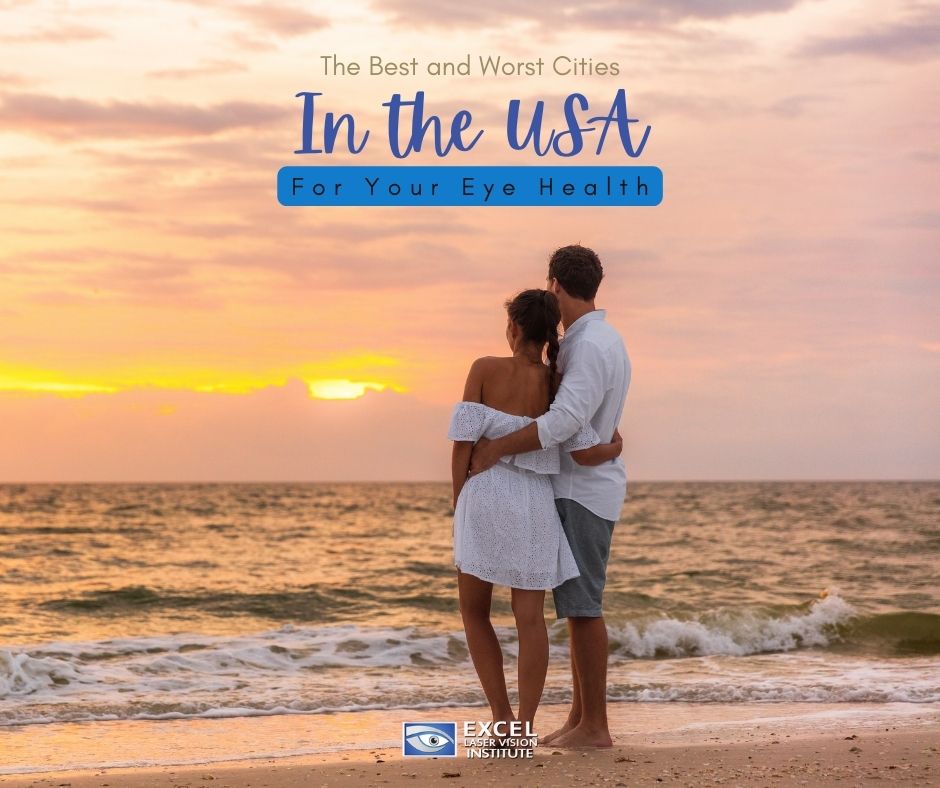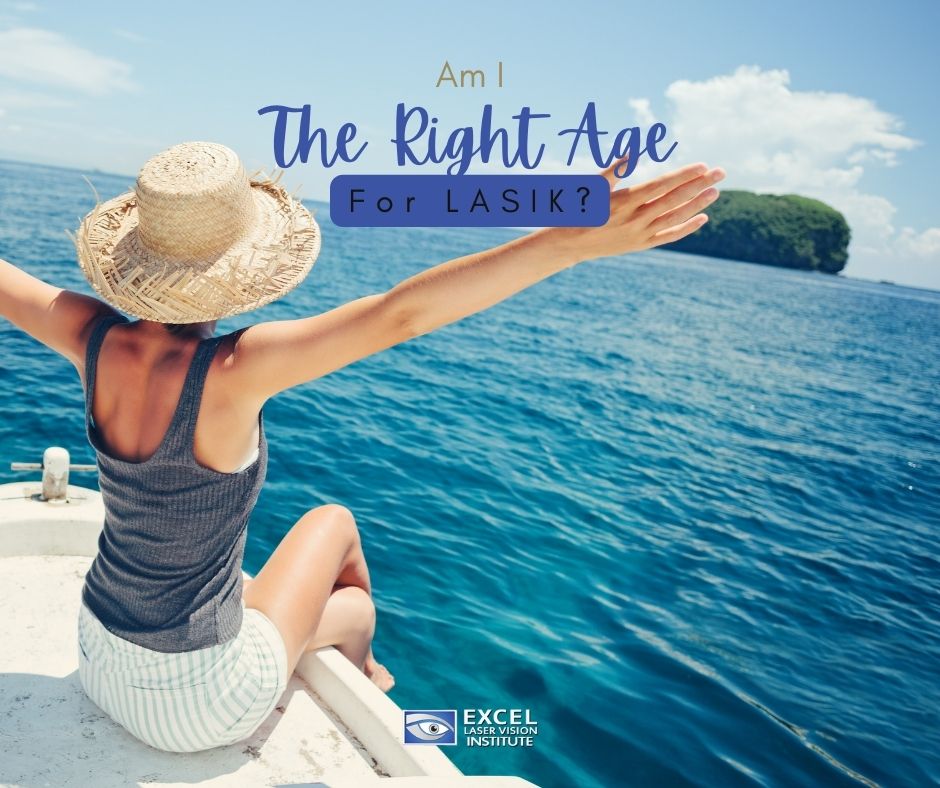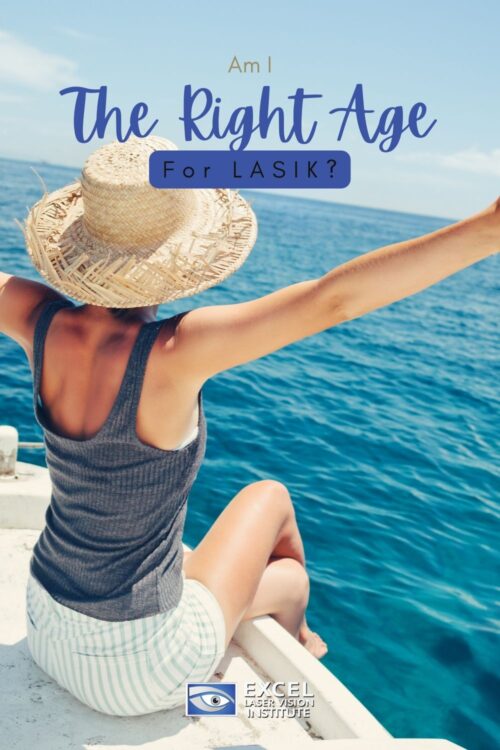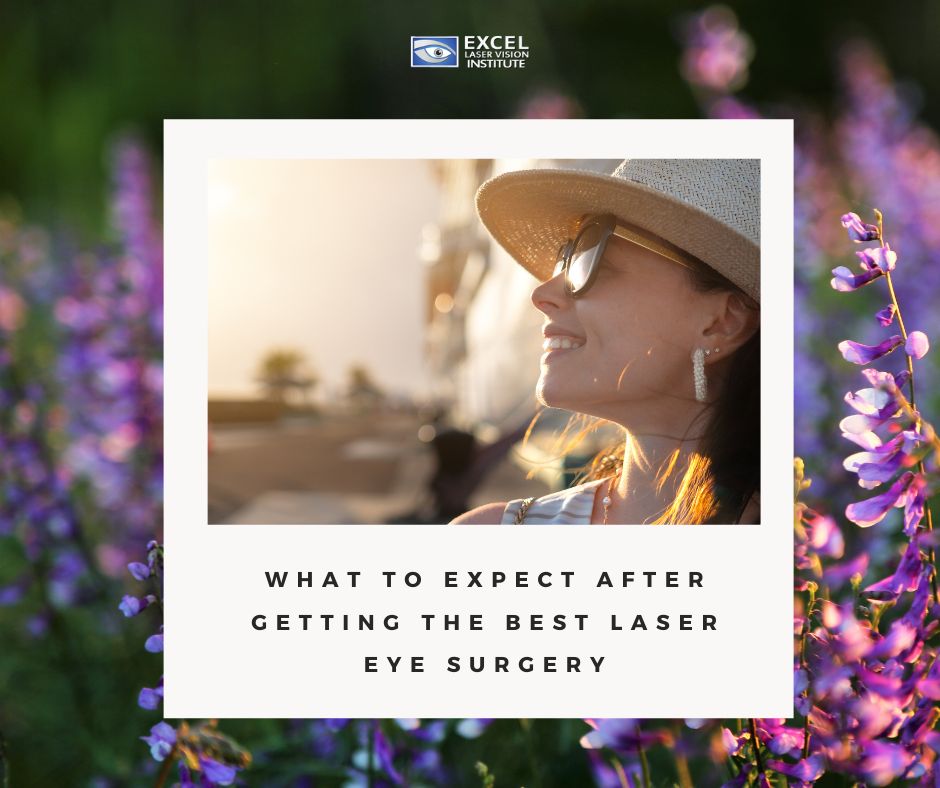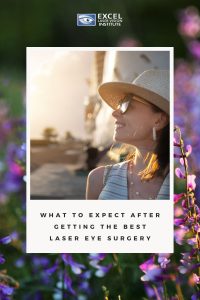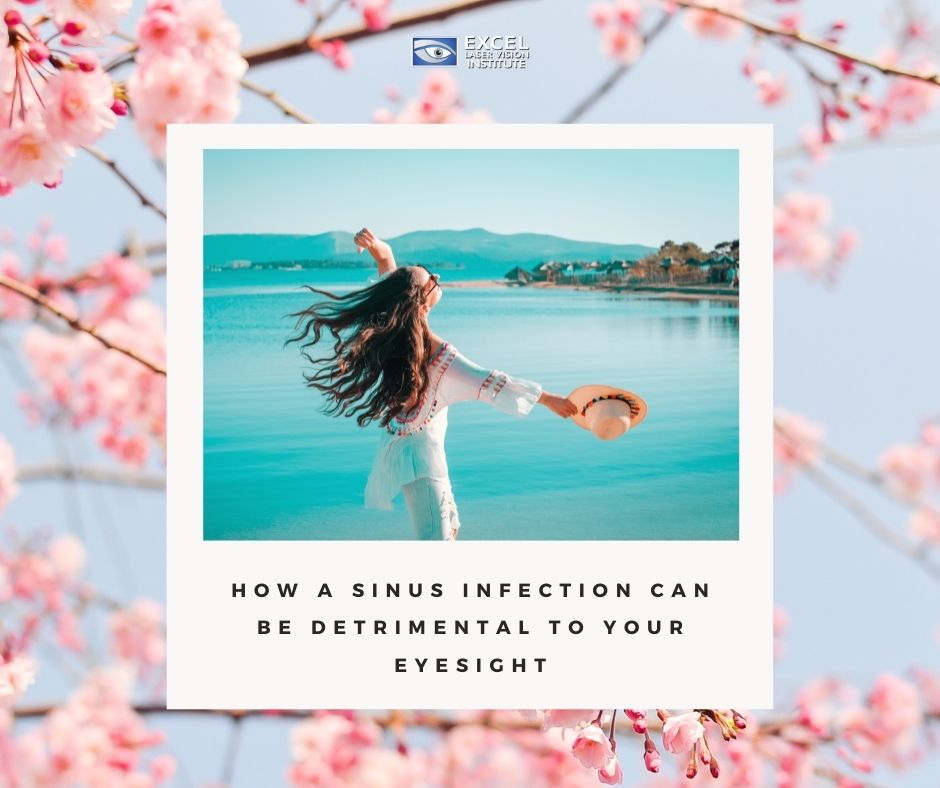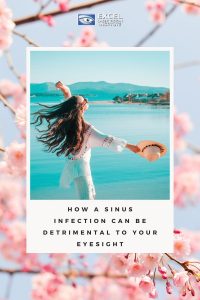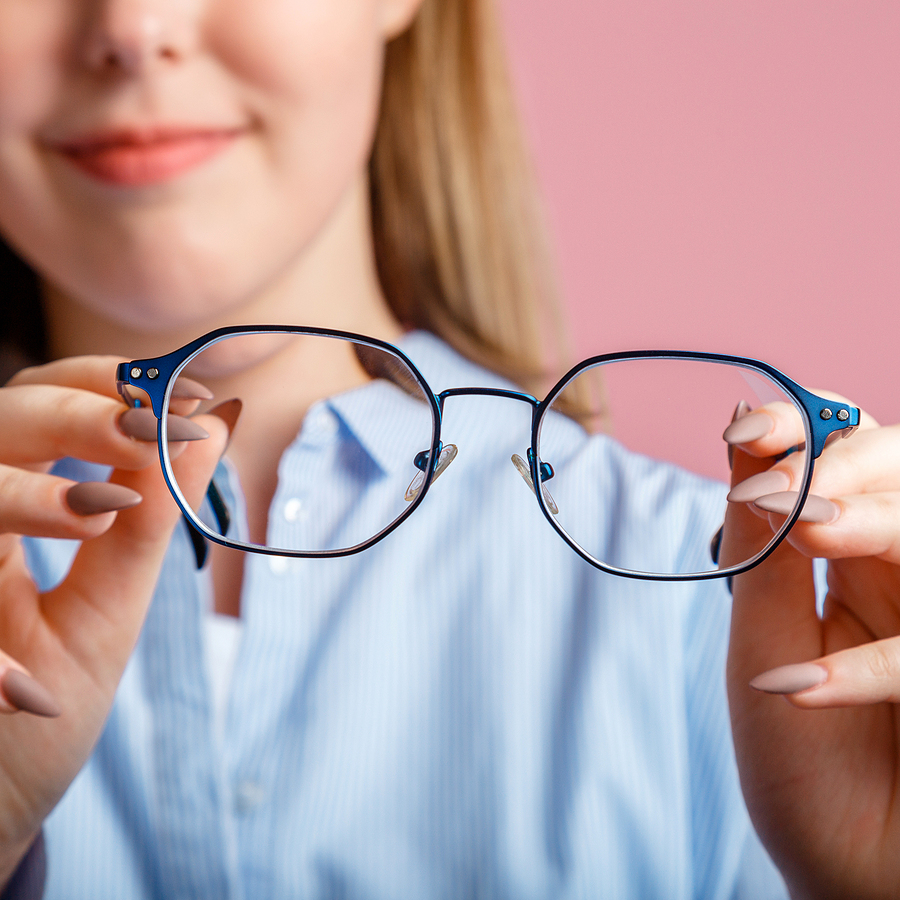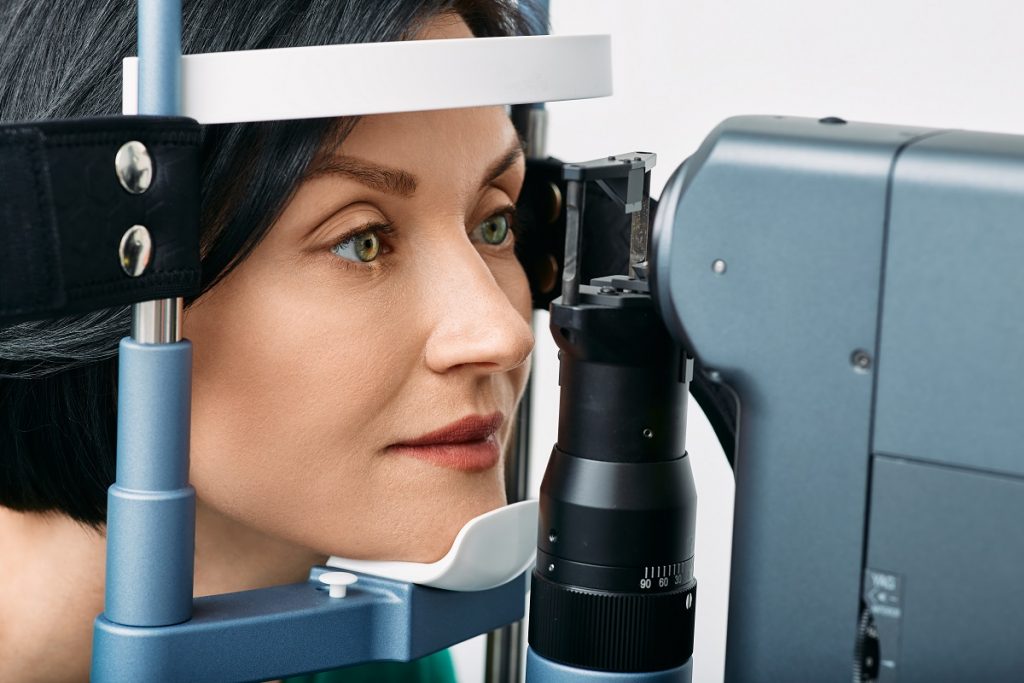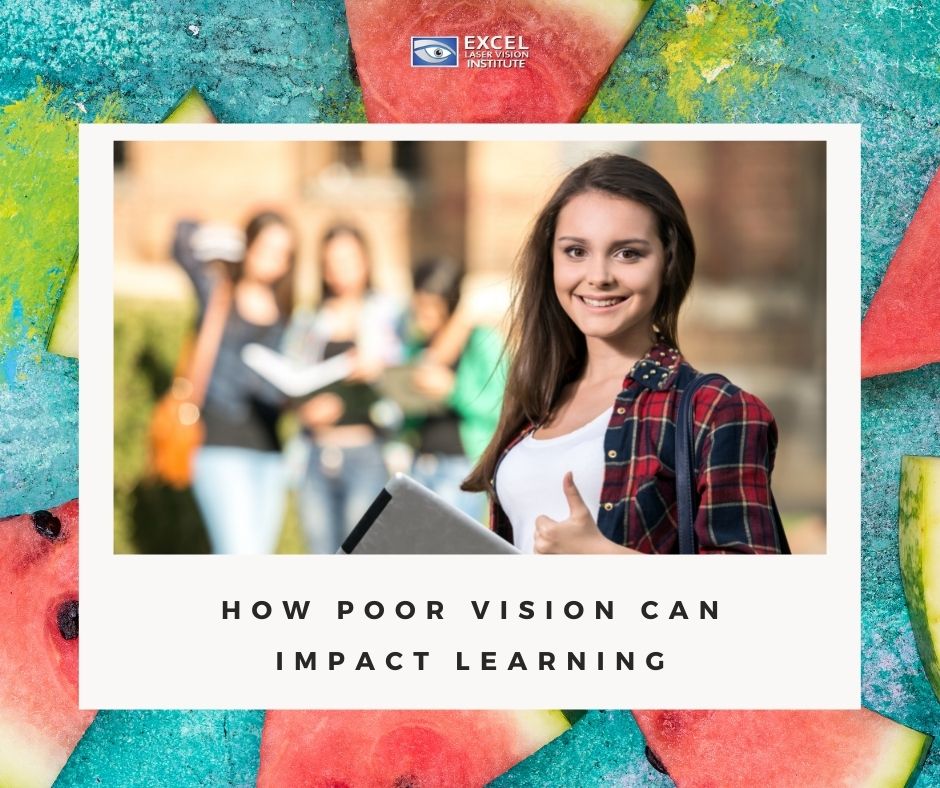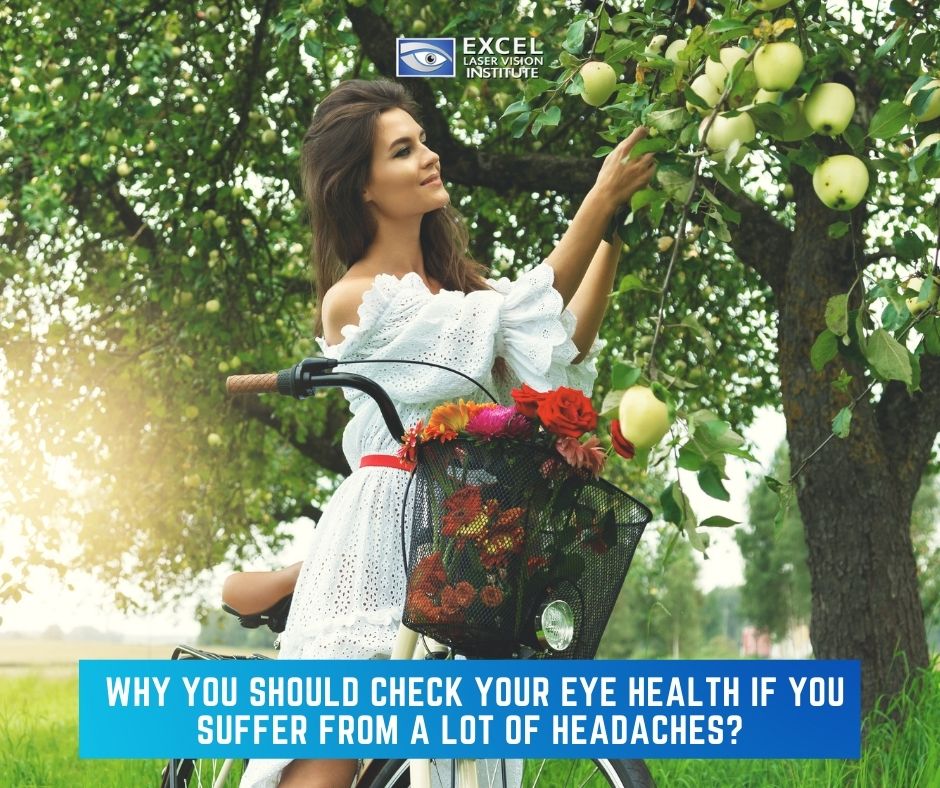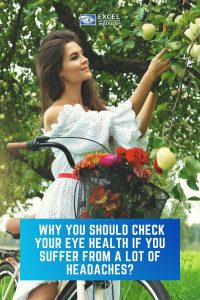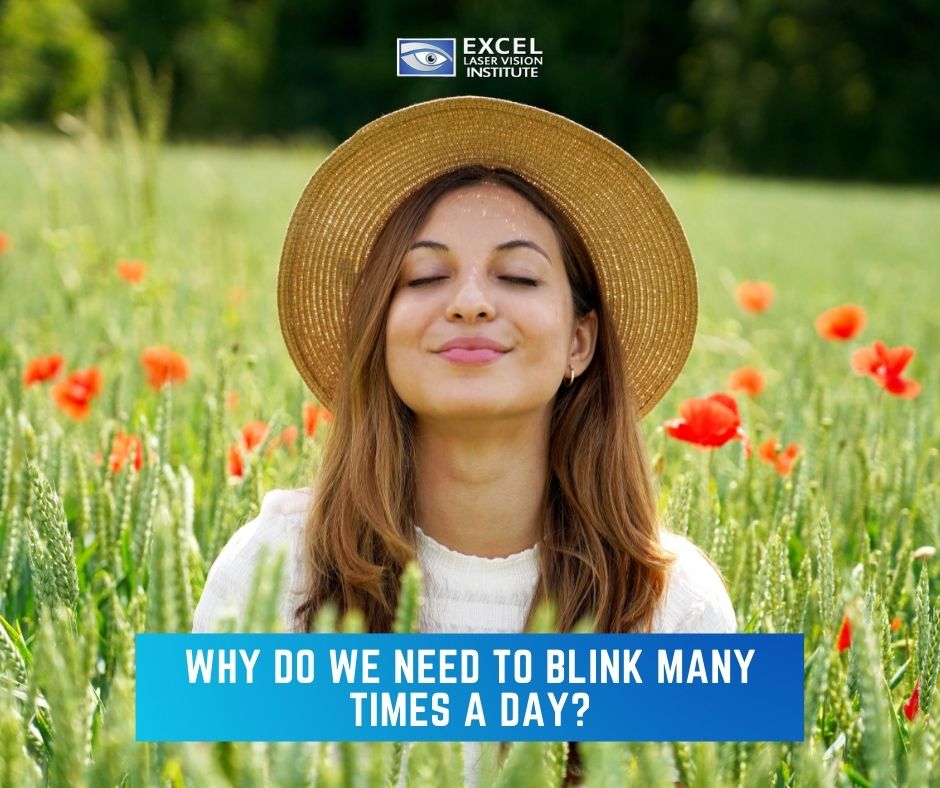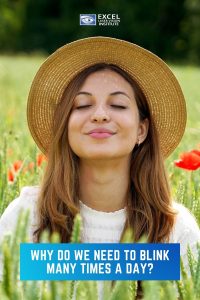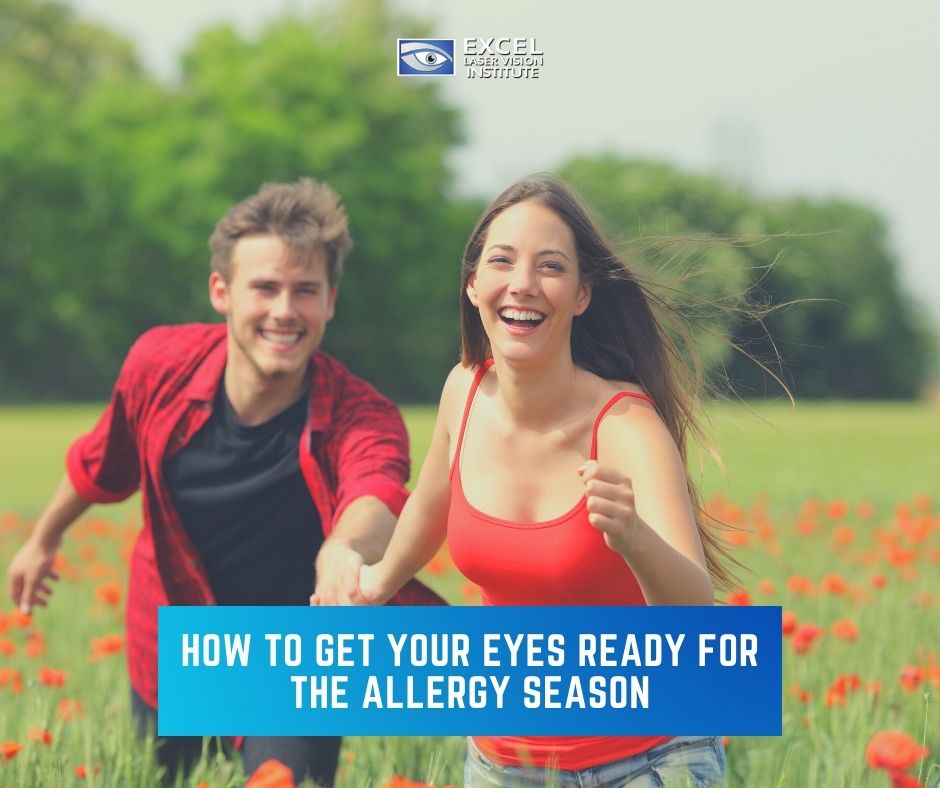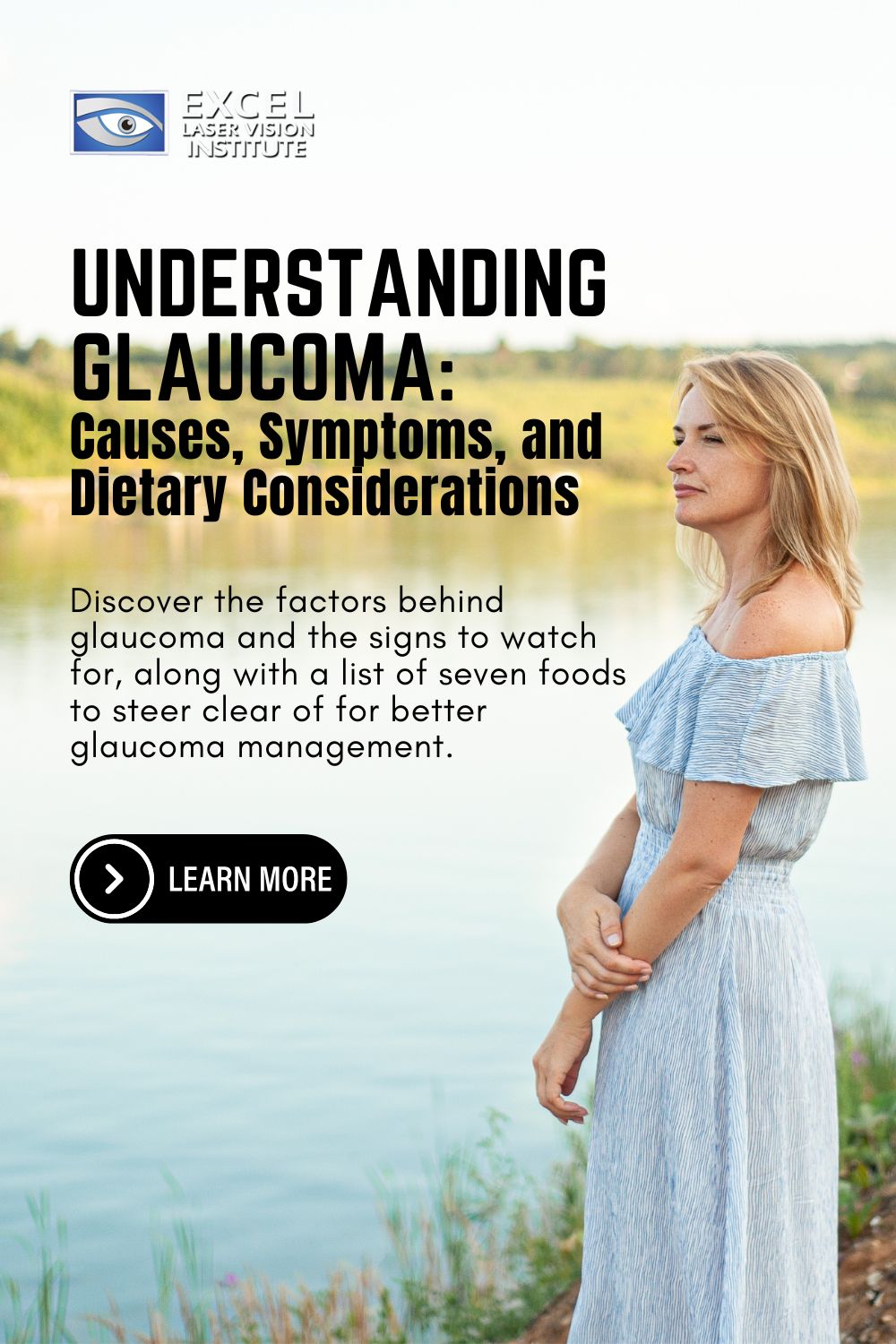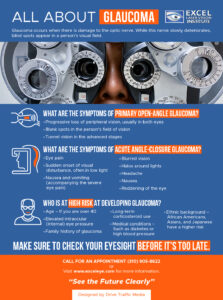
The Best and Worst Cities in the USA for Your Eye Health
Many people don’t consider the environment they live in a factor in their eye health. They don’t realize that external things like weather and living costs can contribute to all sorts of vision impairment problems, even if they practice good habits and hygiene with their eyes.
So, using a combination of factors such as altitude, humidity, temperature, pollution, etc., we’ve compiled a list of the best and worst cities to live in for your eye health.
The Best Cities in the USA for Eye Health
According to an expert LASIK surgeon in Orange County, the following ten cities are the best in the United States for your eye health. Notably, almost all of these are located either in the Pacific Northwest or the Southeast.
- Tacoma, Washington
- Sarasota-Bradenton, Florida
- Charleston, South Carolina
- Mobile, Alabama
- Portland-Vancouver, Oregon and Washington
- Orange County, California
- Honolulu, Hawaii
- Jacksonville, Florida
- New Orleans, Louisiana
- Seattle-Bellevue-Everett, Washington
The cities were chosen based on several factors. We’ll be explaining more about them below.
Altitude
Low altitude cities like Tacoma and Sarasota have an abundance of oxygen in the air. This is important because your eyes (particularly the cornea) lack blood vessels, which means they can’t get oxygen-rich blood from the heart. Our eyes had evolved to get oxygen from our environment instead to keep them nice and moist, preventing them from drying out. This is also why eye doctors recommend you take out contacts a few hours a day—your eyes need exposure to oxygen!
Sun Exposure
Rainy or cloudy days may seem gloomy, but you’d never catch your eyes shedding a tear over it. That’s because too much exposure to UV rays from the sun can cause a variety of diseases like cataracts, eye cancer, and eye growths!
There ain’t much sunshine in Portland or Seattle, but at least you’re protected from the sun’s harmful UV rays!
Humidity
As a provider of laser eye surgery in Orange County, we know how much of a pain in the butt humidity can be. Not only do we have to deal with extremely hot summers, but we also have to deal with being perpetually sweaty and sticky!
Nonetheless, there is a hidden benefit to high humidity. Cities like Orange County and Honolulu are good for eye health because they promote tear production and help our eyes retain moisture. You’re less likely to pull out the eye drops in these cities!
Pollution
While they may seem harmless, pollutants in the air have adverse short-term and long-term effects on your eyes. That’s why people living in cities with low pollution such as Jacksonville and Tacoma generally have healthier eyes—with less dust, dirt, and other irritants floating around in the air, their eyes are clean, moist, and healthy.
Computer Usage
People get distracted way too easily on the computer. Before long, their eyes are dry and tired after spending hours scrolling through Facebook or watching random videos on YouTube!
If you live in New Orleans or Mobile, you probably don’t spend as much time on your mobile phone or computer. We don’t know exactly why that is, but we’re not complaining!
Commute Time
The longer you’re out and about in the city, the longer you’re exposed to pollutants, sun exposure, and other things that can irritate the eye. Unsurprisingly, commute time is a huge factor in eye health given how many people have to commute every day for work or school.
Commuters in smaller cities like Charleston and Sarasota have a shorter commute time.
The Most Eye Health-Conscious Cities in the USA
While the previous section had a list of cities that were healthy for the eyes, this section has a list of cities that prioritize their eye health. Compiled by VSP Vision, the largest non-profit eye health provider in the country, residents in this city are the likeliest to visit their eye doctors for annual check-ups or vision problems.
- Reno, Nevada
- Boise, Idaho
- Oklahoma City, Oklahoma
- Des Moines, Iowa
- Raleigh, North Carolina
- Redding, California
- Colorado Springs, Colorado
- Fayetteville, Arkansas
- Denver, Colorado
- Tulsa, Oklahoma
“An annual eye exam should be a part of everyone’s overall healthcare routine, not only to keep their vision healthy, but also to leverage its proven preventative health benefits,” says VSP Vision President, Kate Renwick-Espinosa. “Your eye doctor is often the first to spot signs of chronic conditions including diabetes, high blood pressure, and high cholesterol. It’s critical that you visit your eye doctor annually to ensure the health of your eyes as well as your wellness overall.”
Looks like the rest of the United States could take a page out of their books!
Another interesting tidbit they found was that women were more likely to visit the eye doctor than men in all cities, both good and bad. 58% of their total respondents were women. Why men are less likely to go for a check-up is another topic entirely, and you could read more about the fascinating psychology behind it here.
The Worst Cities in the USA for Eye Health
On the other side of the spectrum, the following ten cities are the least favorable places to live in for your eye health. If you want to keep your eyes safe and protected, then you need to take extra care and precaution. Otherwise, you’ll have to start saving up for laser eye surgery costs!
- Denver, Colorado
- Albuquerque, New Mexico
- Salt Lake City-Ogden, Utah
- Wichita, Kansas
- Las Vegas, Nevada
- Kansas City, Missouri
- El Paso, Texas
- Chicago, Illinois
- Phoenix-Mesa, Arizona
- Tulsa, Oklahoma
As you can see, the cities are a bit more spread out than in the previous list.
Altitude
High altitude cities like Denver and Salt Lake City have less oxygen in the air, and the weather can get very cold and biting during the wintertime. This combination can be aggravating on your eyes that have to work double-time to keep everything warm and moist!
When it gets snowy and icy in these cities, there’s another worrying condition you need to worry about—snow blindness. This happens when harmful UV rays from the sun are reflected on the ice and into your eyes. It can cause blurry vision, irritation, sensitivity, and even vision loss.
Protective gear like sunglasses isn’t just for summer—they’re also a must for winter.
Sun Exposure
Sunshine might be associated with happiness and joy, but it can get pretty dangerous for the eyes. Too much exposure to sunlight can permanently damage the surface of your eye before you even realize it! As we mentioned earlier, you can develop conditions like cataracts and eye growths easily if you aren’t careful enough.
Always wear sunglasses when walking around Las Vegas or Kansas City!
Humidity
All specialists in LASIK in Orange County would probably agree that low humidity has more disadvantages than high humidity. Not only does it dry out the eyes, but it also dries out the skin (e.g., hands, lips), sinuses, and hair.
Additionally, research has shown that low humidity increases the spread of viruses and bacteria. With less moisture in the air, airborne particles can easily travel around. Our hair-like projections in the nose and lungs called cilia also function less in low humidity, making it harder for them to protect us. This makes us especially vulnerable to viral eye diseases like conjunctivitis.
It would be good to have a humidifier if you live in cities like Mesa and Albuquerque.
Pollution
Larger cities like El Paso and Chicago typically have tons of pollutants coming from car and truck exhausts, factories, construction and demolitions, and more. This makes their residents susceptible to irritation because of all the particles rubbing against their eyes.
Life in the city may not be fun, but be prepared for the onslaught of pollutants!
Wind
If you live in windy cities with air pollution, the last thing you want to do is have the wind blow pollutants and irritants right into your eyes. Tulsa and Wichita ranked high only on this list because a good breeze is enough to have your eyes reddening and stinging.
Computer Usage
Computer vision syndrome (also known as digital eye strain) is a set of conditions caused by excessive screen time on devices. Due to things like extensive computer usage, poor lighting, high glare from screens, poor seating posture, improper viewing distances, and others, people eventually develop eyestrain, headaches, blurred vision, dry eyes, and more.
In major cities like Denver and Chicago where everything is well-connected on the Internet, computer vision syndrome is a major problem. Even worse, it’s not talked about as much because computer usage only boomed in the last decade or so. However, we can assure you that digital eye strain is very much a real thing and something to think about the next time you’re on your computer.
Commute Time
As we mentioned earlier, a longer commute time means longer exposure to the elements. Chicago has one of the longest commute times in the country, along with New York City, Washington D.C., and San Francisco. Additionally, many of the country’s public transportation systems are a haven for pollutants and bacteria, which only makes things worse for your eyes.
The Least Eye Health-Conscious Cities in the USA
If you’re contemplating getting laser eye surgery in Orange County, you’d already be faring a lot better than people living in these cities. According to VSP Vision’s report, people living in these areas are the least likely in the country to visit their eye doctors.
- Cleveland, Ohio
- Bakersfield, California
- Merced, California
- Akron, Ohio
- Albuquerque, New Mexico
- Detroit, Michigan
- Stockton, California
- Santa Rosa, California
- Bridgeport, Connecticut
- Salinas, California
Now, there are plenty of possible reasons why people won’t visit their eye doctors, but probably the most prevalent of them is the expensive cost or lack of coverage in their medical insurance. Indeed, if you take a look at the list, you’ll see that Californian cities comprise half of it. That’s not surprising considering that California is the third-most-expensive state in the country to live in!
Another reason why people don’t go is that they feel like they don’t have to. According to a CDC report done in 2011, many think visual impairments are quite common and are a natural part of the aging process. Thus, they miss out on treating preventable eye diseases early on in their lives and start paying for it twofold as they get older.
Whatever their reasons are, it’s super important to not follow their lead. Not only does taking care of your eye health prevent vision-related problems like glaucoma and cataracts, but it also stays on top of other diseases like diabetes and high blood pressure that can quickly become life-threatening.
Luckily, the state of health insurance has relatively improved since the CDC published its report in 2011. Many insurance companies have started offering eye care as part of their coverage, so annual check-ups to your eye doctor should not be as expensive and inaccesible anymore. Please make sure your insurance provider covers eye care. Some examples include Aetna, Opticare, and United Health Care.
Additionally, many eye clinics have special financing options so you can pay off your procedures without breaking the wallet. At Excel Laser Vision Institute, for example, which is a trusted provider of LASIK in Orange County, we offer CareCredit and Vision Fee Plan that features a 3, 6, or 12-month no-interest payment plan and other extended payment options. Perfect eyesight will never be out of reach for us as we firmly believe this is something everybody deserves.
Always remember that not being conscious of your eye health will cost you not only money but also your vision.
Conclusion
This article is not meant to hype up or bring down certain cities. We know that not everybody has the privilege to live wherever they want in the country. We just want you to be more aware of how geographical locations can affect your eye health as it’s something most people don’t even think about. You need to be cognizant of these various factors so you can take preventive measures for your eye health, such as wearing sunglasses in cities with high UV exposure or carrying eye drops around in cities with low humidity.
Additionally, you can be conscious of your eye health no matter where you live in the country. Take good care of your eyes by practicing good habits and making regular trips to the eye doctor. Your vision is one of the most important senses and it’s important to protect it!
If you’re looking to improve your vision with LASIK in Orange County, then please contact Dr. Ferzaad Moosa at the Excel Laser Vision Institute at (310) 905-8622 today. Alternatively, you can fill out a free consultation form here!
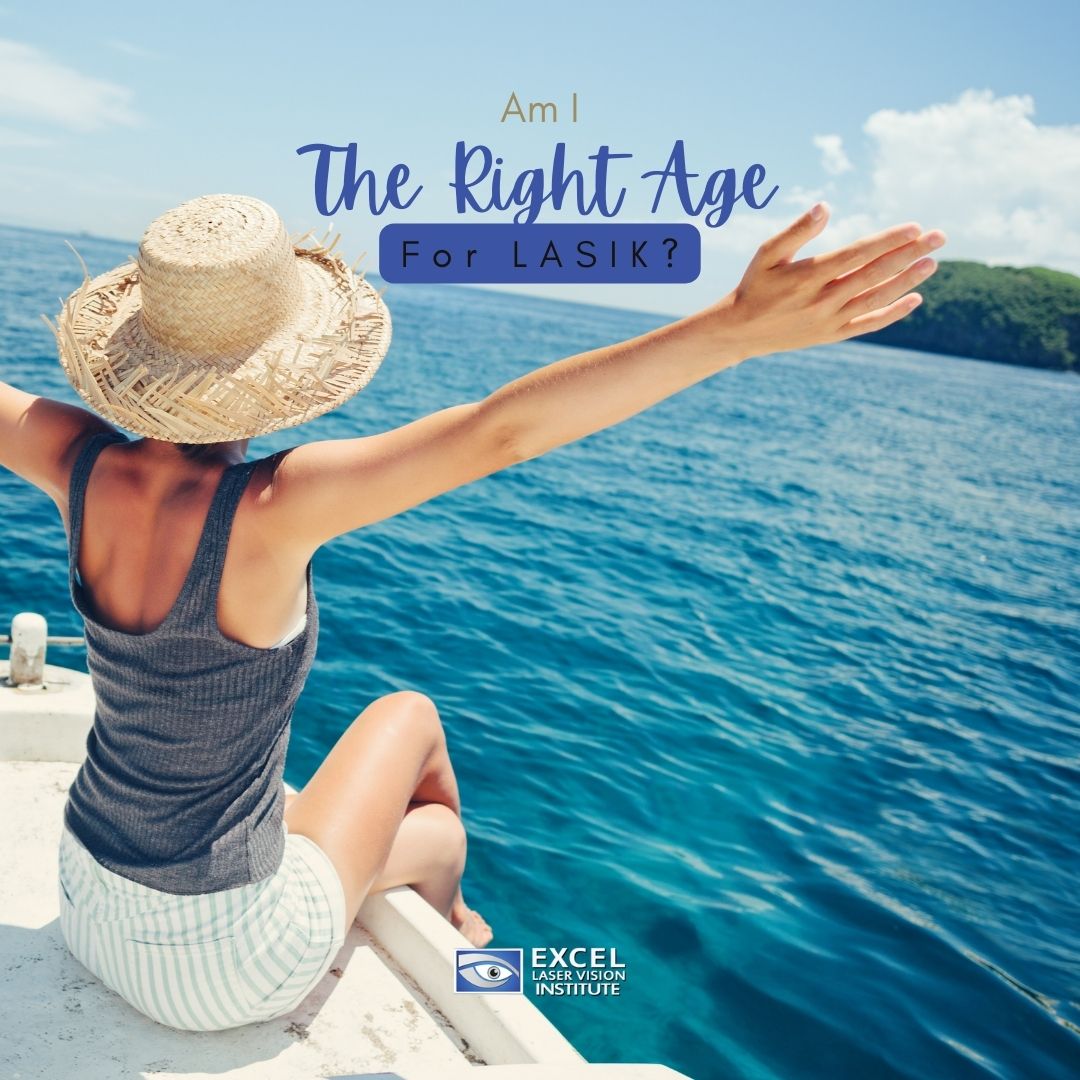
Am I The Right Age for LASIK?
You might have heard about the Goldilocks Effect—it’s a principle derived from the classic fairytale, “Goldilocks and the Three Bears.” Here, a young girl named Goldilocks breaks into a Papa Bear, Mama Bear, and Baby Bear’s house, eats their porridge, sits on their chairs, and sleeps on their bed. In the story, Goldilocks chooses everything the Baby Bear owns because everything was ‘just right.’
The Goldilocks Effect describes how people naturally gravitate towards things that are ‘just right.’ In astronomy, a Goldilocks planet is neither too near the star to be too hot, nor too far to be too cold, allowing living beings to survive. In economics, it refers to three pricing tiers (i.e., high-tier, mid-tier, and low-tier) that cater to all corners of the market. But, did you know that the Goldilocks Effect applies to corrective eye surgery too?
Optimally, you need to be at an age that’s ‘just right’ to get LASIK. That’s because your eye health changes as you age—this affects how well LASIK works.
Now, that doesn’t mean only people of a certain age range can get LASIK! It just means that others need to jump through more hoops to achieve the best results. You must understand how age is a factor in LASIK so you can know what to expect and calculate LASIK eye surgery costs.
What Age is Too Young?
Generally, LASIK isn’t recommended for people younger than 18-years old. Some doctors even recommended their patients wait until they’re 21! That’s because your eyes are still developing at this stage—your near-sightedness, far-sightedness, and astigmatism can still worsen until you reach your 20s. If you undergo LASIK too young, you risk fixing your vision before it’s set, making LASIK less effective.
As you probably already know, LASIK can be pretty expensive. LASIK in Los Angeles, for example, can get up to $4000 per eye! So, unless you’re ready to shell out that kind of money twice, it’s much better to just wait until your vision has stabilized.
What Age is Too Old?
Fortunately, there isn’t a real cut-off age for LASIK. You can even get LASIK well over 60 as long as you meet the necessary qualifications! According to WebMD, a study of 424 LASIK in their 40s to 60s showed that LASIK can still be effective even with the age difference, though they were more likely to get enhancements or repeat procedures.
However, take note that a couple of age-related eye issues will probably make things harder for you. It can affect how well LASIK works the first time you get it, or may even disqualify you from getting LASIK altogether. Here are some of the most common issues:
Presbyopia
Presbyopia is characterized by the gradual hardening of your eyes’ lenses. Because it’s less flexible, it can’t focus as well on close-up objects, making everything look blurry and out of focus. Symptoms of presbyopia include holding objects at an arm’s length to see them clearer, blurred vision, and frequent headaches after using your eyes too close up too long.
Presbyopia is a natural side effect of aging. It starts manifesting as early as your 40s.
Because LASIK only works on the cornea, it can’t do anything to stop presbyopia in your lens. You’ll probably still need glasses if you want to do anything close-up. However, some LASIK doctors address presbyopia by optimizing one eye for close vision and one eye for distant vision. You should discuss presbyopia options with your doctor first to see if they can work for you as this option doesn’t work for everyone.
Cataracts
Cataracts are cloudy areas in your eye that develop when proteins clump together. This prevents your eye from getting clear images, and when left untreated, can cause total blindness. This is commonly seen among older people—according to the World Health Organization, approximately 65.2 million of them around the world are affected by cataracts.
The prevention and treatment of cataracts are totally irrelevant to LASIK. If your vision is affected because of your cataract, LASIK isn’t going to do anything to help it. You’ll need to get your cataracts removed first before you can get LASIK surgery, and a separate surgery is needed to get cataracts fixed if you get them after LASIK.
Glaucoma
Glaucoma is a condition in which your eye’s optic nerve is damaged. It is caused by high pressure in your eye and can lead to total blindness. There is no cure for glaucoma, and you’ll really need to monitor your progress every few years to prevent it from progressing further.
LASIK works on the cornea of your eye, making it thinner. This, then, makes it harder to diagnose glaucoma in its early stages and monitor glaucoma in its moderate and severe stages. If you’re someone with glaucoma or are at high risk of glaucoma, we don’t recommend getting LASIK.
What Age is Just Right?
Many eye health experts agree that age 25 to 40 is the ideal age for LASIK. At this point, your prescription has stabilized and will likely remain consistent for years to come. Depending on your health (e.g., family history of diabetes or cardiovascular disease that are risk factors for cataracts) and eye health (e.g., dry eye syndrome, which disqualifies patients because of decreased tear production), most people at this age are likely to be approved for LASIK.
Conclusion
In short, Goldilocks should probably get LASIK when she’s around 25-40 years old, though she can get it as early as 18. This age range is ‘just right.’ Anything below 18 should not be considered.
Once Goldilocks is past 40, she’ll need to have her doctor screen her eyes for age-related eye conditions that can affect the effectiveness of LASIK. There’s still a huge chance she can get LASIK at this age, but she needs to be aware that the outcome may not be quite the same because of presbyopia, or that she needs to deal with more serious eye issues like cataracts and glaucoma first before thinking about getting LASIK.
Now, before anything else, Goldilocks needs to have a consultation with a professional LASIK surgeon. This article is only a guideline, so she’ll need more expert advice to see if she’s qualified for corrective eye surgery. A LASIK surgeon will take her general health, eye health, and age all into consideration and figure out the best way to achieve the perfect vision for her.
If you’re just like Goldilocks and need an expert opinion from a LASIK surgeon, then Dr. Ferzaad Moosa will be glad to help. He has performed LASIK in Los Angeles and Orange County for the past 23 years and is a certified member of the Board of Ophthalmology. And what’s more—his consultations are free of charge!
Contact his clinic today at (310) 905-8622 or visit his online consultation form here to get started.
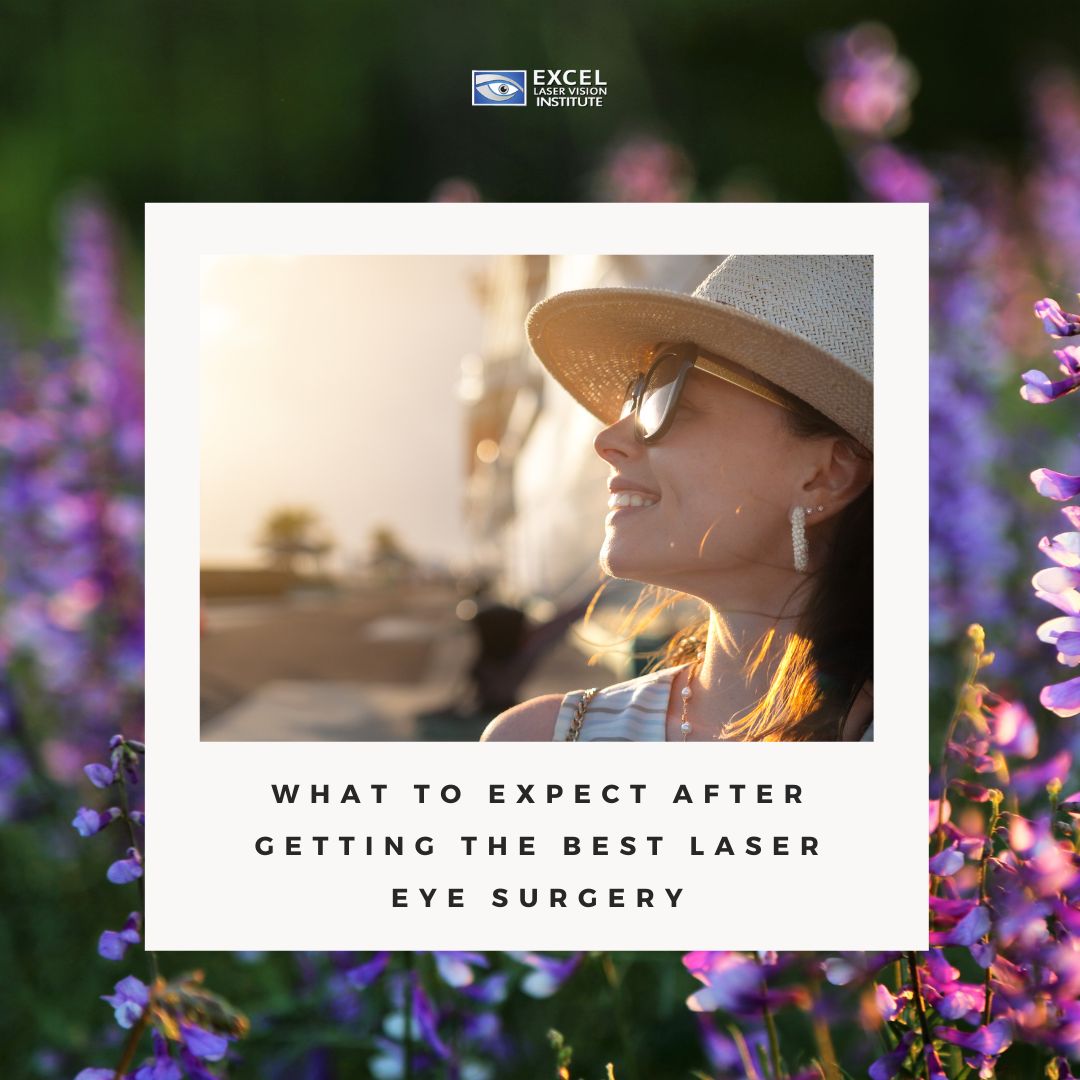
What to Expect After Getting the Best Laser Eye Surgery in Los Angeles
The best LASIK surgeons in Los Angeles agree that proper aftercare is crucial to having a successful surgery. You need to treat your eyes with a lot of care and love as they just went through a lot of work, as I’m sure anyone would need if they had lasers set on them!
Here’s what to expect after getting your life-changing laser eye surgery.
The First Few Hours After Your Surgery
After the surgery is completed, your eye surgeon will let you take a little cat nap to let your eyes recover from the ordeal. Then, when you open your eyes again, you’ll notice that everything around you will be pretty foggy like you’ve just opened your eyes underwater.
This can be a little disconcerting, but you shouldn’t worry about it. It’s completely normal! Your vision will eventually clear up the more your eyes heal, though some of our past patients had reported being very impressed by what they could already see the second they opened their eyes.
However, since your vision is still pretty affected, you still won’t be allowed to move around on your own. All LASIK surgeons will require a companion with you to either drive you to and from the appointment or guide you around public transportation. This is for your safety and the safety of others.
Your surgeon will also require you to wear eye shields. These need to be worn the whole day after your surgery and often the next few days as they will protect your eyes from damage. Eye shields prevent you from accidentally touching or rubbing your eyes, especially when you’re asleep and can’t control your movements. It also protects you from bacteria moving from your bedsheets or pillows to your eye.
And speaking of sleep, you’ll be doing a lot of it once you get home from your surgery. Sleep is the #1 way to let the eyes heal, so have a minimum of four hours of shuteye for a faster recovery process.
Once you wake up for the second time, the effects of the anesthesia will have worn off. You might experience discomfort and even pain—some of our patients describe it as having something sharp stuck in your eye, or a burning sensation that won’t go away.
Use your prescribed medications to help soothe your eyes. They should help you manage your pain by preventing infection and reducing inflammation. They also stop your eyes from itching by keeping them well-lubricated.
Here’s a neat trick: if your surgeon allows it, you should refrigerate your eye drops! They feel so good in the eye and can wake you up really quick.
The First Few Days After Your Surgery
As we mentioned earlier, you’ll need to wear your eye shields for the next few days to protect your corneal flap. While they’re technically only required at night, we still highly recommend wearing them whenever you can, especially if you’re prone to reaching for your eyes.
While you’re outside, you can start switching to sunglasses—they’ll protect your delicate eyes from the harsh UV rays and is something everybody should do even without getting LASIK. This is also super important as your eyes will still be pretty sensitive to light post-surgery.
Now, when it comes to taking a shower, you need some extra protection. Having unfiltered water and chemical-laden shampoos in your eye is a first-class ticket for harmful bacteria and unwanted pain. That’s why we highly recommend wearing swimming goggles or face shields while you’re showering, as these will keep your eyes nice and dry while you wash off. Alternatively, you could also keep your eyes firmly shut while you wash your hair, and then quickly wipe off the water with a towel after you’re done.
Not showering at all is also an option, albeit a slightly smelly one.
Lastly, you’ll need to visit your doctor for a follow-up appointment a day or two after your surgery. They’ll need to monitor your early recovery to see if it’s going as planned. Here, you can tell them what kind of side effects you’re experiencing—if you have dry eyes, puffy eyelids, excess tears, or any other condition, your doctor can prescribe something to help.
The First Few Weeks After Your Surgery
While the recovery process for LASIK Los Angeles is pretty quick, there are some things you still need to limit.
For one, you need to spend less time in front of your computer or reading. These activities contribute to dry eyes. If you must, just make sure to use your eye drops frequently to keep them lubricated.
Secondly, avoid wearing makeup products altogether. Eyeshadows, eyeliners, mascara, and other products have bacteria in them that can get transferred over to your eyes. This is why you should avoid large bodies of water like pools, lakes, and oceans too—they’re cesspools of bacterial contamination!
Thirdly, avoid being in places that have a lot of dust, dirt, and smoke. The tiny particles can enter your eye and can exacerbate the itchiness. Trust us, when you’ve got a healing corneal flap, the last thing you want to do is get a dust particle lodged in there! Avoid gardening and heading to places with lots of air pollution.
About a month after your surgery, you’ll be cleared for vigorous activities like aerobic exercises and weightlifting. With that said, you’ll still need to wear polycarbonate sports glasses to prevent trauma, even if you’re not required to wear eye shields to sleep anymore.
Your vision will fluctuate during this period as your eye heals even more. This is normal. Contact your surgeon only if your vision gets worse or if you start feeling pain for no reason.
The First Few Months After Your Surgery
It’ll take up to six months for your vision to stabilize, and it’s important to have regular check-ups with your eye surgeon. As we mentioned earlier, they can track your healing process, prescribe medications, and identify any issues before they get any worse. Aim to visit them at least once every month.
As your vision stabilizes, you might have problems with halos, starbursts, glares, and others. They resolve themselves for the most part, but in some extremely rare cases, they might not be fixed. Your vision could also not be 100% even after proper healing. In that case, you can consult with your doctor and see if this is something that can be fixed with another surgery, free of charge.
LASIK in the Long Run
Now, keep in mind that LASIK isn’t a magic surgery that’ll make you immune to all future eye problems. LASIK only fixes irregularities in your cornea—it doesn’t prevent irregularities that eventually develop in other parts of your area. As you get older, you can become nearsighted or farsighted again due to conditions like presbyopia and hyperopia. You can also develop eye problems like glaucoma and cataracts.
However, these conditions don’t usually show up until you’re well in your 40s. You’ll have lots of time to enjoy the benefits of your LASIK, free of pesky eyeglasses and contacts. Savor it while you can!
10 Realistic Expectations Regarding LASIK
Realistic expectations are crucial when considering Los Angeles LASIK (Laser-Assisted In Situ Keratomileusis) surgery, as it’s a medical procedure that can significantly improve vision but may not guarantee perfect results for everyone. Here are some realistic expectations you should have about LASIK:
Improved Vision
LASIK can effectively correct refractive errors such as nearsightedness (myopia), farsightedness (hyperopia), and astigmatism. The primary goal of LASIK is to improve vision, often reducing or eliminating the need for glasses or contact lenses for many everyday activities.
Reduced Dependency on Corrective Eyewear
While LASIK can significantly reduce dependency on glasses or contacts, it may not eliminate the need for them in all situations. Some individuals may still require reading glasses for close-up tasks due to presbyopia, a natural aging change in the eye that typically occurs after age 40.
Potential for Complications
Like any surgical procedure, LASIK carries risks and potential complications, although rare. These may include dry eyes, glare, halos, fluctuations in vision, undercorrections, overcorrections, and, in rare cases, more severe complications such as infection or corneal ectasia.
Realistic Vision Expectations
While LASIK can provide excellent visual outcomes for many individuals, it’s essential to understand that achieving “perfect” vision is not guaranteed. Factors such as the severity of refractive error, corneal thickness, pupil size, and individual healing responses can influence the final visual outcome.
Time for Healing and Stabilization
It takes time for the eyes to heal and vision to stabilize after LASIK surgery. While some individuals may experience improved vision immediately or within a few days, others may require several weeks or months for optimal results. Following post-operative instructions and attending follow-up appointments to monitor progress and address concerns is essential.
Possible Need for Enhancement
In some cases, additional procedures or enhancements may be necessary to achieve the desired visual outcome after LASIK surgery. This may occur if there is residual refractive error, undercorrection, overcorrection, or regression of the initial correction over time. Your surgeon can discuss the possibility of enhancements based on your circumstances.
Long-Term Results and Stability
While LASIK can provide long-lasting visual improvement for many individuals, the stability of the results can vary. Factors such as age, hormonal changes, eye health, and lifestyle factors can influence the long-term stability of the correction. Some individuals may experience changes in vision over time and may require additional vision correction.
Pre-Existing Eye Conditions
LASIK may not be suitable for individuals with certain pre-existing eye conditions or factors that increase the risk of complications. These may include cataracts, glaucoma, severe dry eye syndrome, corneal abnormalities, or autoimmune diseases affecting the eyes. It’s essential to undergo a comprehensive eye examination and evaluation to determine suitability for LASIK surgery.
Continued Eye Care
Even after successful LASIK surgery, it’s essential to maintain regular eye exams and follow-up care with an eye care professional. Routine eye exams can help monitor eye health, detect any vision changes, and address any potential issues promptly to ensure long-term ocular health and visual stability.
Satisfaction with Improvement
While LASIK can significantly improve vision and quality of life for many individuals, satisfaction can vary from person to person. Having realistic expectations and understanding that LASIK is not a guarantee of perfection but a treatment option that can substantially benefit many individuals is essential.
Conclusion
Having realistic expectations about LASIK surgery is essential for making an informed decision and achieving satisfactory outcomes. While LASIK can significantly improve many individuals’ vision and quality of life, it’s essential to understand the potential risks, limitations, and variability in results. By discussing your goals, concerns, and expectations with a qualified eye care professional, you can decide whether LASIK is the right choice for you.
If you’re interested in learning more about LASIK, why not contact the office of Dr. Ferzaad Moosa? He is a licensed, board-certified surgeon that has been offering high-quality LASIK in Los Angeles for the past 23 years. He’ll help you achieve the perfect vision with outstanding talent, revolutionary technology, and state-of-the-art care facilities.
Visit our website here and fill out our free evaluation form. You could also contact us at (310) 905-8622 to set an appointment.
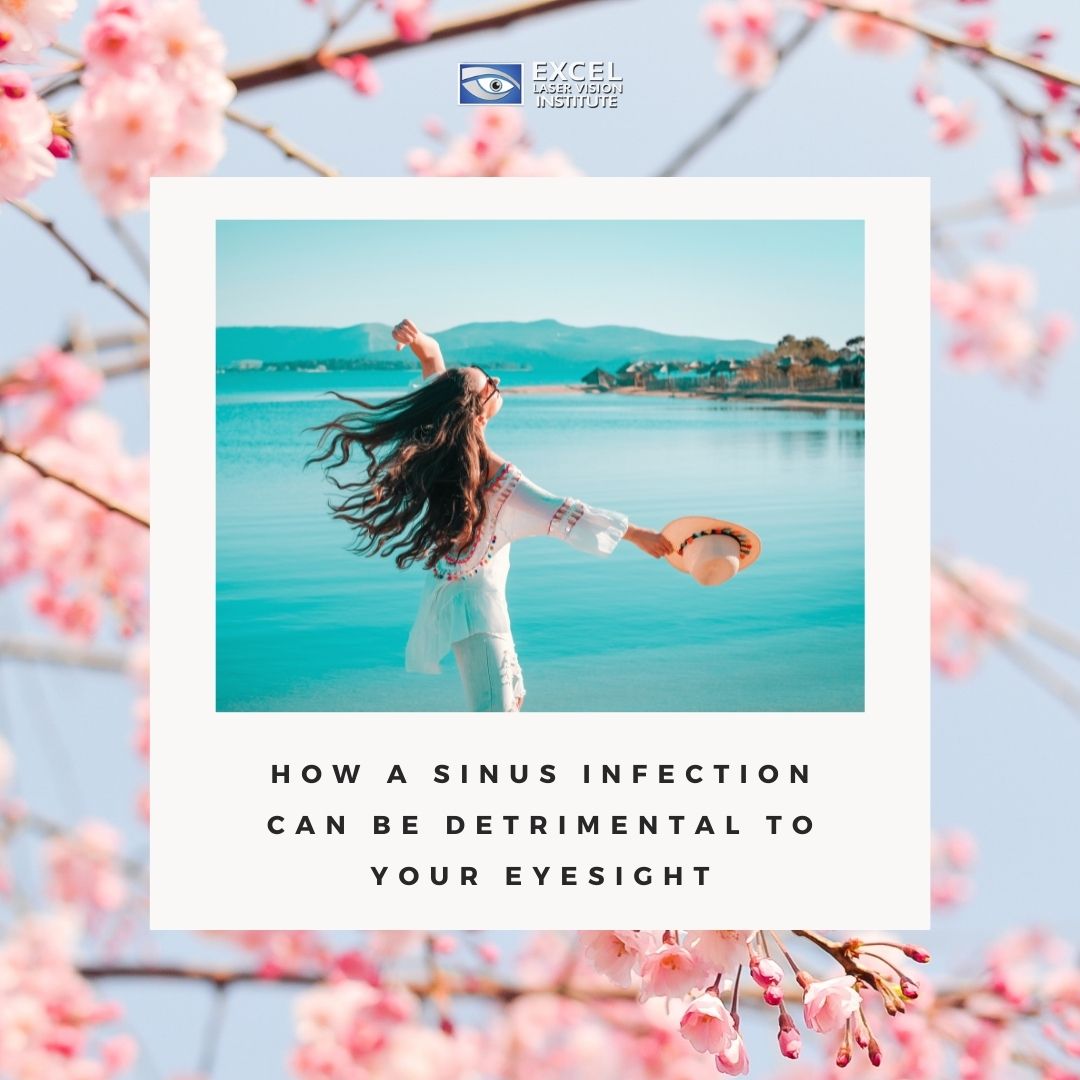
How a Sinus Infection Can Be Detrimental to Your Eyesight
When you get a sinus infection referred to by doctors as sinusitis, naturally, you are most likely to be concerned with how your nose and your head feel. It is normally caused by seasonal allergies, with over 3 million cases each year in the United States. It normally means no need for panic; however, this relatively brief illness can also negatively impact your eyesight, even if you do not experience any pain. Our Los Angeles LASIK team wants you to understand how you can better take care of your eyes if you are more prone to bouts of infections such as these.
There are 3 types of sinus infections that we should be familiar with:
Acute sinus: The symptoms are present for 4 or fewer weeks.
Subacute sinusitis: The symptoms last between 4 to 8 weeks.
Chronic sinus: The swelling of the sinus has been occurring for more than 3 months. Medical attention is necessary.
The most predominant symptoms of sinus infection include:
Basic congestion
Cough
Facial pain or pressure
Fatigue
Headache
Heavy eyelids
Mucus dripping down the throat
Pressure alongside the temples
Runny nose
Sore throat
Stuffy nose
Unpleasant breath
Now, while sinus infections rarely stay for the long haul, the big and quite unfortunate catch is that a more serious case of the illness can actually bring about permanent damage to your eyes. Since your sinus cavities can swell as a result of sinus infections, which are located in the bones around your nasal passages around your eyes, naturally, it can cause them to become irritated. This potential permanent damage to your eye socket can result in either blurred vision or even blindness, and unfortunately, Los Angeles LASIK eye surgery is not equipped to treat these conditions.
How to Treat a Sinus Infection
Depending on the severity of your symptoms, a variety of treatments may be necessary. You may be able to take over-the-counter antibiotics, saline nasal spray, or allergy medication if you are experiencing acute sinus. If you find that these methods aren’t working even after a few weeks, then you might be experiencing a more serious form of the illness and should consult a doctor before it’s too late. Be clear with your doctor if you are experiencing any pain or discomfort in any area of your body so that the problem can be properly assessed and diagnosed.
How to Prevent Your Chances of Getting Sinusitis
Drink an adequate amount of water each day
Clear excess mucus from your passages by running water through them once a day
Inhale steam
Avoid dry environments when possible
Avoid contact with others who are ill
Once you are healthy again, if you are interested in undergoing LASIK in Los Angeles, go ahead and reach out to our Encino office at (310) 905-8622. Our Harvard-educated and trained physician, Dr. Moosa, as well as his committed team, can make your dream of a clear vision a reality. Schedule your free consultation appointment with us to discuss the specifics of your procedure, including LASIK eye surgery cost as well as the outcomes. Our Los Angeles LASIK center has proudly accumulated more than tens of thousands of satisfied patients accumulated over the last 23 years, and you are bound to become one of them!
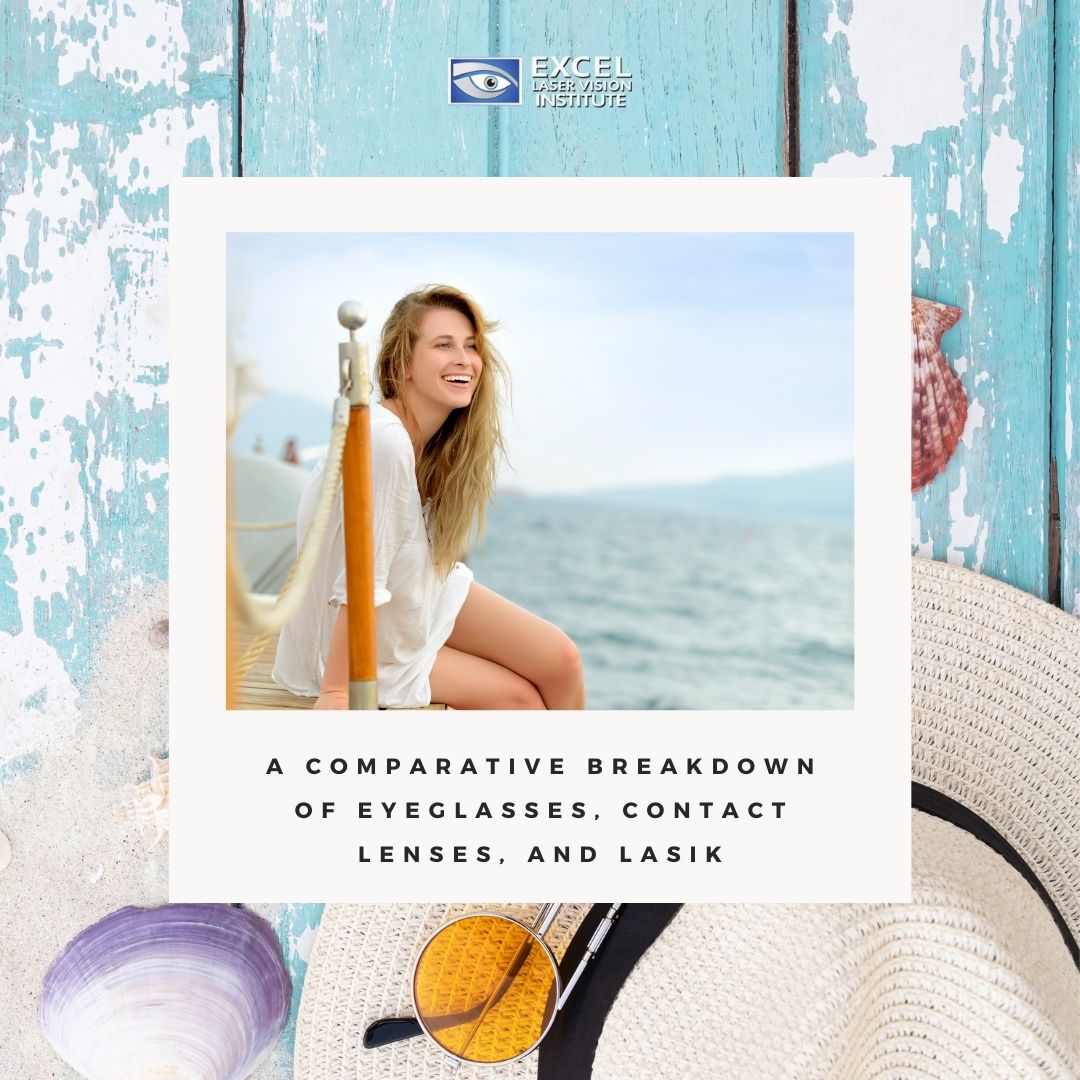
A Comparative Breakdown of Eyeglasses, Contact Lenses, and LASIK
Advantages and Disadvantages
According to the World Health Organization (WHO), there are at least 2.2 billion in the world with some type of vision impairment. In most cases, vision impairment either could have been prevented easily or has not yet been addressed with corrective measures like eyeglasses, contact lenses, or LASIK.
In this article, we’ll be looking at the different ways to correct eyesight and their various advantages and disadvantages.
Eyeglasses
Wearing eyeglasses is the easiest way to correct your vision. In fact, some people even wear eyeglasses despite not having any vision problems—it’s seen as a fashion statement that can complement your outfit, make you look smarter and more knowledgeable, and improve your look overall. There are tons of eyeglasses designs with different shapes, styles, and colors to choose from.
Eyeglasses are also pretty nifty because they’re easy to maintain. If the lenses are dirty, you can wipe them with a clean cloth or even the bottom of your T-shirt. They’re also easy to put on and remove, making it easy to switch to a different pair or take them off right before heading to bed.
The disadvantage to a good old pair of eyeglasses is their inconvenience. You can’t wear them for every occasion—you can’t swim in a pool or ride a roller coaster, for example, and if you get them wet or foggy, you’d need to take them off and clean them before you can see properly again. What’s more, you can’t wear certain things like sunglasses or goggles because of it too.
Additionally, eyeglasses are clunky and ridiculously easy to lose. As a four-eyed person, I can’t remember how many times I’ve acted like Velma in Scooby-Doo and gone out of commission due to losing my eyeglasses. And it’s not like you can slip them into your bag whenever you need to either, as the lenses get scratched and damaged easily.
So, while eyeglasses are certainly quirky and easy to wear, they definitely leave a lot to be desired.
Contact Lenses
Contact lenses are the answers to problems eyeglasses pose.
They are extremely thin films put directly on your cornea—they’re basically your eye’s second skin. You can go about your day-to-day activities and not feel them bothering you, and you can even do things like ride roller coasters and snorkel with contacts on (although it’s not recommended to open your eyes underwater with contacts on)! They also won’t change your appearance, which is good news for anyone who hates the way they look with eyeglasses on.
The downside to contact lenses, though, is how annoying they can be to maintain. Every morning and every night, you need to spend a few minutes putting contacts on carefully, so they’re smooth and aligned perfectly to your iris. You need to soak them in a cleaning solution and store them properly, too, as they get dirty quite easily and can seriously infect your eye. Lastly, contacts can be quite aggravating to those with sensitive eyes and scary for newbies. After all, the idea of something pressed that close to your eye can be intimidating.
LASIK
LASIK is the only permanent solution to vision impairment on this list. It involves cutting into your eye and altering the inner tissues carefully with high-precision lasers.
The best part about LASIK is that it’s, like we said, permanent. Once you have LASIK, your vision is mostly corrected, and any remaining issues can be easily resolved with a few more minor surgeries. Your vision will be as good as new, and you won’t have to wear eyeglasses or contact lenses for the next few years.
Some things turn people off from LASIK, however. For one thing, it can be pretty daunting. Nobody likes the idea of having their eyes cut open and having lasers shot at them. There are also plenty of misconceptions about LASIK—although untrue, many people still believe them.
Additionally, LASIK can be very expensive for some. The cost per eye is somewhere between $1500 and $4000, depending on where you live. With rising prices on everything, it’s definitely a huge investment you can’t take lightly. Some would consider the hassle of eyeglasses and contacts preferable to expensive LASIK costs.
Cost Breakdown
But is LASIK really too much money for what it’s worth? Let’s break it down.
To make things clearer, we’ve calculated the total costs of eyeglasses, contacts, and LASIK in twenty years. Let’s assume that our patient is Samantha, a 25-year-old nearsighted female with a moderate case of astigmatism. She has both eyeglasses and contacts, and her prescription increases every four years. She’s now considering doing LASIK in Orange County, California, where she lives.
Eyeglasses
The national average cost of eyeglass frames is around $250, so Samantha expects to pay at least that much whenever she purchases a new pair. The actual price Samantha pays for her glasses will depend on the eyeglass design she picks (e.g., Target, Ray-Ban, Dolce & Gabbana, etc.), the lenses she picks (e.g., plastic, polycarbonate, bi-focal, etc.), her prescription, and her health insurance coverage.
It will also depend on whatever add-on she chooses—some retailers offer transition lenses, thin and lightweight lenses, blue light protection anti-reflective coating, and hydrophobic coating. That’s not included in the price, so that’s an additional cost.
All in all, let’s say a pair of eyeglasses for Samantha will cost her around $400 with all the bells and whistles.
Now, let’s calculate the doctor’s appointments. Samantha will need to visit her doctor so they can prescribe new eyeglasses for her. Eye exams range from $50 and $250 but are covered by most health insurances, so let’s say this brings down her total expenses to $120. She’ll need to visit the doctor again sometime afterward to check up on her new glasses, adding another $120 to her cost for a total of $240.
Lastly, with a pair of eyeglasses that expensive, she needs to buy the necessary supplies to take care of them! She needs a cleaning cloth, a cleaning spray, and a case to maintain them. The average cost of these on Amazon is around $20 and will last her, say, six months.
So, the total cost for her pair of eyeglasses is $640—$400 for the eyeglasses and $240 for doctor appointments and eye exams. She pays $20 every six months for cleaning supplies.
Contact Lenses
How much Samantha will spend on her contact lenses will largely depend on the kind of contact lenses she uses. Some contact lenses are designed to be replaced and disposed of daily, weekly, or monthly. Some contact lenses increase in price depending on prescription, astigmatism, and add-ons like UV protection. Some contact lenses are more expensive simply because they’re a different color.
We already know that the average cost of doctor’s appointments, eye exams, and fitting sessions is $240 from the last section. You will need to have a prescription before buying contacts.
Now, Samantha would prefer to change her contacts daily as she feels this is more hygienic, and she tells her doctor this. She also wants lenses with UV protection as she lives in very sunny California. So, after a thorough examination of her eye and considering her wishes, Samantha’s doctor prescribes 1-Day Acuvue Moist for Astigmatism.
These contacts come with 90 lenses per pack. Samantha plans on buying a year’s supply as it’s cheaper than buying monthly. As a reference, Walmart offers a yearly supply of these contacts for $340 ($85 per box)—Samantha could still get it for a cheaper price depending on her health insurance and any other discount programs. So, let’s say that Samantha pays $250 for the year’s supply in the end.
Now, she needs to buy a couple of things to keep her contacts nice and clean—firstly, a standard 12 oz. bottle of contact disinfecting solution. A bottle usually lasts one month and costs around $8. Secondly, eye drops to keep her eyes lubricated the whole day. This will cost her around $5 per month. Lastly, Samantha needs a case to keep her lenses protected when not in use—they average around $7 for several pieces.
So, in total, Samantha spends $13 for contact lens care and maintenance, and $7 for cases that need to be replaced every three months.
It’s important to note that people who wear contact lenses are encouraged to visit their doctors yearly instead of bi-yearly. This is because contact lens complications can get serious very quickly due to the delicate nature of the eye.
LASIK
Now, an average LASIK surgeon in Orange County typically charges $1500 to $3000 per eye, so let’s say Samantha is paying $2000 for each eye—$4000—with an esteemed eye surgeon. LASIK isn’t a procedure covered by most health insurance companies in the United States, so she has to pay for this out of pocket.
That $4000 should cover everything from pre-surgery consultation and evaluation, the surgery itself, and any post-surgery check-ups and medications like eye drops. Because her eye surgeon was a good one, she left the surgery with perfect 20/20 vision and does not need any additional surgeries (though even if she did, that $4000 should still cover it).
Her vision has now been permanently corrected. She will not run into any problems for the next twenty years. When she turns 45, she starts experiencing presbyopia, which is the gradual inflexibility of the lens. This is something most people her age goes through and is irrelevant to the effectiveness of her LASIK.
Table of Computations
This is a table of Samantha’s total expenses. Take note that these computations were made assuming Samantha was going to replace eyeglasses every four years and contact lenses every year. This table also assumes that prices will be stable for the entire twenty years—the actual total could be a lot different.
Corrective Measure | Cost Per Purchase | Cost After 20 Years |
Eyeglasses | $400 for eyeglasses + $240 for doctor’s appointments + $160 for miscellaneous = $800 every four years | $4000 |
Contacts | $250 for a year’s supply of contact lenses + $240 for doctor’s appointments + $156 ($13*12 months) for cleaning + $7 for cases = $653 every year | $13060 |
LASIK | one-time payment of $4000 | $4000 |
Analysis
Now, eyeglasses may be annoying to wear at times, it’s probably the most budget-friendly option here. If taken care of properly, they can last up to four years, and the total cost in twenty years is easy to pay as you don’t have to pay all of it at one time. Additionally, this computation assumes Samantha pays for high-quality eyeglasses with extra perks—you can totally get a pair that’s cheaper if you find that easier.
Contact lenses are the most expensive as it needs takes a lot to care for them. They need constant cleaning, constant replacing, and constant trips to the doctor because of how dangerous improper maintenance of contact lenses can be. In twenty years, you’ll have spent more than three times as much as you had spent on eyeglasses!
Lastly, while LASIK is the most expensive option in this article, you can’t deny that it’s a great investment. In twenty years, Samantha will have completely made up for the LASIK eye surgery cost, and all that without visiting the eye doctor regularly, getting new prescriptions every year, caring and maintaining for eyeglasses and contacts, and other hassles that they bring. With LASIK, she will have little to no issues for the next twenty years.
Conclusion
Eyeglasses, contact lenses, and LASIK offer various advantages and disadvantages depending on your prescription, financial capabilities, and preferences. If you’re looking to correct your vision and are currently weighing your various options, we hope that you can look to this article to find your best bet.
As an expert on LASIK in Orange County, Dr. Ferzaad Moosa would no doubt recommend laser eye surgery. It’s quick, painless, convenient, and a good bang for your buck. If you’re interested in learning more about LASIK, including questions about the process, costs, and health insurance coverage, feel free to contact our clinic at (n310) 905-8622 or at our website.
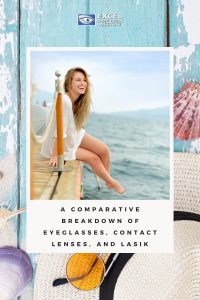

How Poor Vision Can Impact Learning
We have all heard of the three predominant learning styles, visual, auditory, and tactile – but what about people who may learn best visually but cannot see very well? It doesn’t take a doctor to know that it can be more difficult to learn if you have poor eyesight. According to research, 65 percent of the general population are visual learners. So in a sense, a majority of people truly need to “see it to believe it.” If you learn better by seeing things but were not blessed with the best vision, you may find that you are not reaching your full potential in your academics or in your professional life. This is where you may turn to LASIK surgery in Los Angeles to solve the problem.
You may try to compensate for your low vision by trying the other learning methods, possibly if the conversation about the cost of LASIK eye surgery sends a shiver down your spine. While some people may be able to work with multiple learning styles, it may or may not be the case for you. Perhaps you find it difficult to read directly from a textbook and you do not enjoy audiobooks or there are none available. Studies have proven that having bad eyesight also directly impacts one’s ability to retain information. “Blurry vision equals blurry brain,” says Dr. Lynn Greenspan, an optometrist based in Elkins Park, Pennsylvania. “With bad input, the brain doesn’t receive a complete picture and needs to work hard to fill in missing details.” It goes without saying that if you have difficulty remembering new information, then learning new information will serve as a particularly tall order for you. Those who struggle with memory have also been found to have more emotional health issues. A 2016 Japanese study found that those who chose to undergo LASIK “significantly improved vision-related psychological concern and physical function,” this increasing patients’ HRQOL (health-related quality of life). Think of it this way, after undergoing Los Angeles laser eye surgery, you will no longer have to worry about forgetting or losing your glasses. You can walk out of the house feeling more confident than you ever have before!
So if you have always wanted to enhance your eyesight, then you are in good company. Perhaps you are a current post-secondary school student, whether you are an undergraduate, a graduate student, or in a doctorate program, who wants to enhance your vision so that you can perform more accurately in your studies. You might be tired of the glasses or contacts you have grown accustomed to wearing since your childhood. If so, you have come to the right place. Please reach out to us by calling our staff at (310) 905-8622 for a free Los Angeles LASIK consultation. We strive for the highest quality of professional service for every patient who visits our offices. With 23 years of excellence provided by Dr. Moosa and his team, we firmly believe the decision to get Los Angeles LASIK eye surgery with us can be one of the best decisions you will make for yourself for years to come.
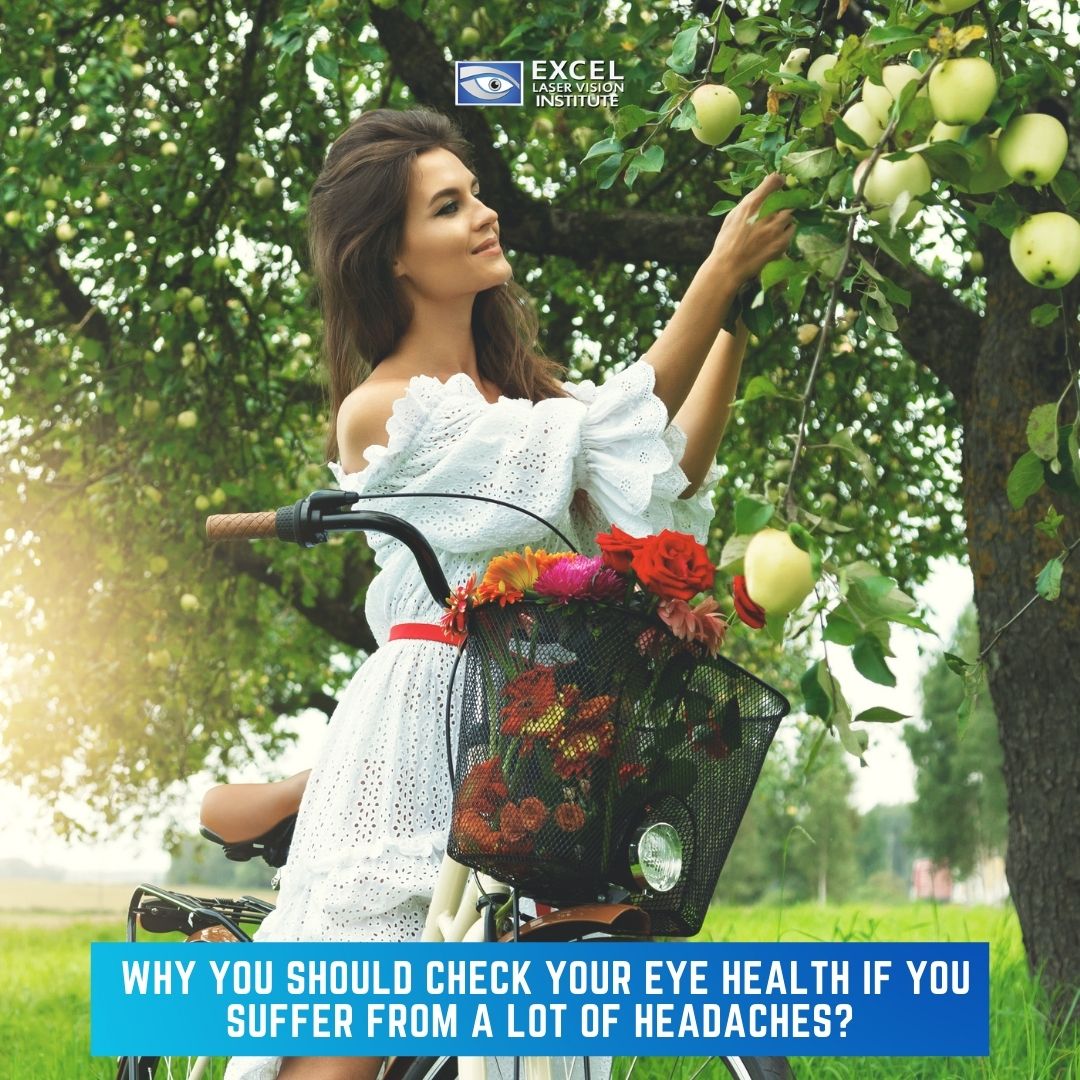
Why You Should Check Your Eye Health If You Suffer From a Lot of Headaches
Headaches are a common pain that many people experience from time to time. However, having pain behind your eyes can wreak havoc in your life especially when you got a lot of things to do. If you often have a headache or even every day, that regularity may mean there is something more serious lurking.
If you have a lot of headaches, book an eye exam right away, and you should see if you can rule out any vision problems as a cause. Headaches are not always linked to vision issues, and every vision problem does not cause headaches, but there is a considerable connection between the two.
If your headaches have caused you to change your routine, you should make your doctor aware of this. He or she will consider your situation and prescribe a treatment based on what could be triggering your headaches, symptoms, and pain location.
What Is A Headache Behind The Eyes?
It is not uncommon for people to complain about headaches behind the eyes, and they may arise from underlying health problems ranging from eye strain to migraine.
When you have pain behind the eyes, it can affect one or both sides and may happen with light sensitivity and other kinds of discomfort. A doctor can recognize the cause of a headache behind the eyes and suggest the most suitable form of treatment.
Here is some more information about what causes headaches behind the eyes and how to treat them.
Migraine
About 16% of adults in the United States suffer from a common condition known as migraines.
A migraine headache can bring about extreme pain on one side of the head, sometimes behind one eye. This pain can last around 72 hours.
Besides a migraine headache, a person may experience:
weakness
dizziness
nausea and vomiting
sensitivity to light and sound
mood changes
visual disturbances, known as aura
What Causes Migraines?
Doctors are not sure what causes migraines. Nevertheless, modifications to nerve signaling and blood vessels in the eye may be involved in its development.
Exterior triggers are usually the catalyst for migraine attacks. Typical migraine triggers include:
hormonal changes
lack of sleep
dehydration
environmental factors, such as smoke, strong smells, or flickering lights
consuming too much caffeine or alcohol
strong emotions, such as stress or anxiety
Eye Strain
Technology has brought a new type of eye issue known as computer eye strain, also referred to as digital eye strain and even computer vision syndrome. It’s an umbrella term that consists of several vision-related conditions. People sometimes experience discomfort in their eyes because they focus on electronic screens for long periods.
Apart from discomfort in one or both eyes, a person that spends immense, undisrupted periods looking at screens or digital devices may experience any of the following symptoms:
headaches
dry eyes
neck and shoulder pain
blurry vision
An individual may only feel discomfort behind their eyes after staring at digital screens for long periods, and symptoms may improve when they stop doing so. Nonetheless, the prevalence of these computer-related symptoms is increasing quickly, and if a person keeps experiencing symptoms, they may need medical assistance.
What Causes Eye Strain?
Concentrating and reconcentrating on a screen for a long time can cause eye strain, resulting in vision issues.
A person will usually experience eye strain after concentrating on a single object or task for a long time. Also, dimly lit areas and exhaustion can cause eye strain.
Sinusitis
Sinusitis occurs when there is inflammation or congestion of the sinuses, and this can produce pressure, causing pain behind the eyes. Susceptible to the location of the inflammation, sinusitis may cause pain behind both or either eye.
Additionally, sinusitis can cause pain and pressure in other parts of the face, for instance, the cheeks and forehead.
Other common symptoms of sinusitis include:
fatigue
nasal congestion
aching in the upper teeth
pain that worsens when the person is lying down
Sinusitis is a common condition, and pain will usually clear up when the overall congestion does. This will often take two to three weeks.
What Causes Sinusitis?
Commonly, sinusitis occurs when allergies or a virus get trapped within the sinuses due to congestion, which can result from face pressure and headaches. Plus, sinusitis may have bacterial or fungal causes, even though these are often linked to immune deficiencies, such as HIV.
Also, nasal polyps and dental surgery can result in sinus pain and pressure.
Cluster Headaches
When a person has one to eight brief, but painful headaches over a day, they probably had a cluster headache.
These headaches are painful and happen on one side of the head. This may be a reaction from sharp or dull throbbing pain behind only one eye.
Frequently, additional symptoms develop on the same side as the headache.
These symptoms can include:
a stuffy or runny nostril
flushing
sweating
The time at which a person experiences cluster headaches is different for every one. However, it is not unusual for people to experience them at night.
What Causes Cluster Headaches?
Medical professionals do not know what causes cluster headaches, and there has not been a lot of research about them, even though these headaches are not uncommon.
Typically, researchers believe that more males usually experience cluster headaches than females. Also, there may be a genetic component, and some people probably have a higher risk than others.
Tension Headaches
Most of the time, people experience tension headaches, which are more common in females than males.
A few people experience tension headaches one to two times per month while others experience them more frequently. If this goes on for three months or longer, doctors consider these headaches chronic.
Typically, tension headaches cause pain behind both eyes and a sensation of pressure around the forehead. They can happen at any time and can last from 30 minutes to several hours. In severe situations, a person may experience symptoms of a tension headache for several days.
Plus, a tension headache can cause sensitivity in the scalp. Tension headache pain may be dull, happen in the forehead, and go along the neck.
What Causes Tension Headaches?
Tension headaches develop for a variety of reasons, including:
stress
lack of sleep
staring at a screen for a long time
driving long distances
muscle contractions in the neck or head
What Are Good Treatments For Headaches Behind The Eyes?
You can get over-the-counter pain medication to alleviate mild or moderate headaches, but prescription medication may be needed when the pain is severe.
A doctor may prescribe antiseizure medications, antidepressants, or oral birth control pills as preventive measures for people who experience frequent migraine headaches. An individual can get relief from a migraine episode by resting in a darkened room. Also, putting a cool, damp towel over the eyes may help too.
Muscle relaxants are a short-term alternative for the management of tension headaches.
If a person has headaches caused by bacterial sinusitis, a doctor will probably prescribe antibiotics. However, nasal decongestant sprays are a good option if an allergy or viral infection brings about sinusitis.
Try to schedule time for a regular eye exam whenever you can, especially if you’ve been suffering from frequent headaches and don’t know what is causing them.
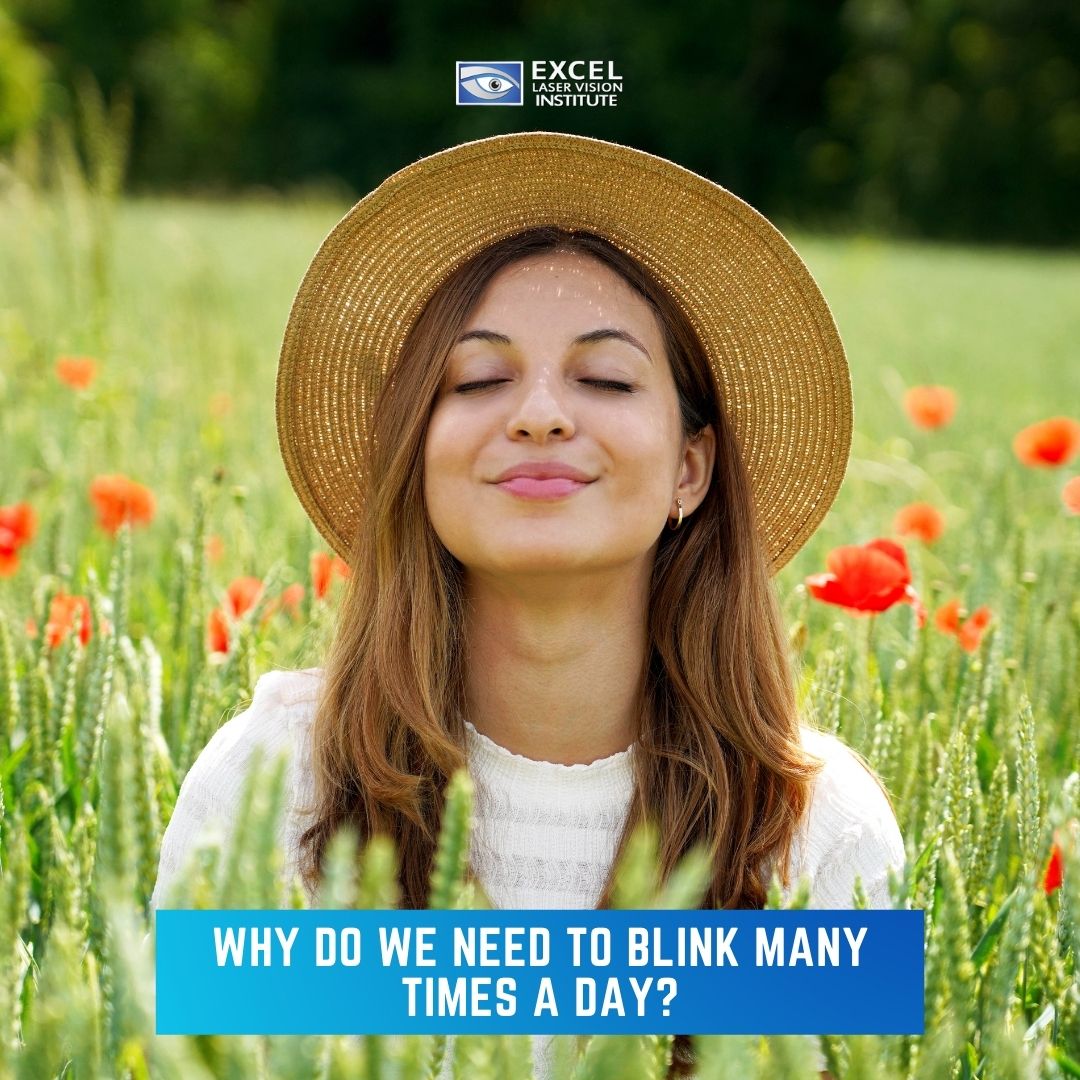
Why Do We Need to Blink Many Times a Day?
Many of us in our younger years have been in a staring contest. Remember how difficult it was to keep your eyes open for such a long time? Eye doctors tell us it is because of our natural instinct to blink. However, what are the reasons behind our need to blink?
Apparently, there are two main reasons for blinking. First of all, blinking clears away particles from the eyes. For instance, if there is a foreign body in the eye, it helps to remove it. Sometimes particles get under the eyelid or else something blew in. Also, this can feel very painful since there are many nerve endings in the cornea.
Secondly, blinking helps to lubricate the eyeballs. The eyes need a smooth surface for light to correctly focus on, so vision doesn’t get blurry. Bling brings out a tear film, which usually consists of water, mucus, and oil to maintain a smooth eyeball surface. Also, it prevents the eye from drying out which can feel uncomfortable. Typically, when your eye has a large area of dryness, it kind of feels like a scratch on your cornea, the eye’s outer protective layer.
Secondly, blinking lubricates the eyeballs. The eyes require a smooth surface for light to focus properly, so you don’t have blurry. Blinking releases a tear film — which mostly includes water, oil, and mucus — to maintain a smooth eyeball surface. Also, it stops the eye from drying out, which can be uncomfortable. When there is a large area of dryness, it feels similar to a scratch on the cornea, – the eye’s outer protective layer. This can be very distressing since there are many nerve endings in the cornea.
Why Is Blinking So Important?
Our eyes have to blink several times every minute, but do you completely understand why it’s so critical for optimal eye health?
You can time yourself for a minute and notice how many times you blink. On average, adults blink between ten and twenty times per minute, with each blink lasting a tenth of a second.
When We Blink, Our Eyes Get Cleaned And Refreshed
Each time our eyes blink, they spread fresh layers of tears throughout the eyes’ surface, preventing them from drying out and removing small irritants such as dirt and dust particles that could obstruct vision. When the eyes have too much moisture, the excess tears drain out through the very small holes at the corners of the eyes (the tear ducts) and down into the nasal passages. So, if you have ever asked yourself why your nose usually runs when you cry, now you understand its cause!
We Usually Blink Less When Focusing
Occasionally, when we are fixating on something such as a game, book, project, or TV show, the eyes usually blink less than usual. As a matter of fact, as little as three times per minute. That’s a lot lower than the healthy rate of blinking our eyes depends on carrying out their job effectively. If the eyes go a long time with less than normal blinking, it risks dry eye or eye strain.
Make Blinking More A Habit
Sometimes not blinking enough can lead to eye issues, especially when you’re doing something that needs you to focus. So, try to make a conscious effort to blink more. If you work on it continuously, you can train your eyes to blink a lot more out of habit. To force yourself into the habit of blinking more, you could even set reminders to do blinking exercises every hour. You will soon find that you won’t need reminders anymore. An excellent, simple exercise to help maintain fresh feeling eyes is to close them, wait a moment, squeeze your eyelids, and then open them again.
The Systems Behind Blinking
Although blinking seems to be a very simple thing to do, it needs a lot of various mechanisms working together harmoniously in our eyes and eyelids, including different types of tear production, tiny glands making oil to refill the film that prevents our tears from drying out, and many assorted sets of muscles to carry out the physical movement of blinking. Several things can go haywire when there are so many moving parts. If you have dry eyes or eye strain and blinking exercises are not doing it for you, talk to your eye doctor at Excel laser Vision Institute!
How To Blink Your Eyes
Yes, indeed, there is the right way to blink your eyes! As you know by now, the purpose of blinking is to refresh your eyes by moistening them with protein-rich nutrients, cleaning them of any foreign objects, and giving them the much-needed lubricant they require. This may sound like a lot to ask from just one blink, but those are the advantages of this straightforward action.
To blink correctly and efficiently two factors have to happen: closing the eyes completely for a short moment and using the correct eye muscles.
The muscles that are used for blinking are situated above the eyes. To ensure you are using these muscles instead of facial muscles, place your fingers at the corners of your eyes by the temples. Close your eyes. You should not sense any movement under your fingers if you used your eye muscles.
Once you close your eyes, pause. This step is vital since if you want the blink to be effective, the eyes have to be completely closed. You can quickly test this by placing a finger under your eye, just above the cheekbone. When you close your eyes, you should sense your upper eyelashes touch your finger.
Advantages Of Blinking
When you become an expert on the blink technique, you are set to get the perks. During the blink, protein-rich moisture coats your eyes, providing them with essential nutrients. Also, this liquid cleans the eyes, getting rid of any dirt or debris. Plus, an oily substance is discharged, which helps prevent moisture from evaporating too rapidly while also lubricating the eyelids to stop chaffing.
How does all this happen? When we blink, we squeeze the glands in the eyes that create these liquids. Therefore, nourishment, cleansing, and oily lubrication are common results of the glands releasing this needed tear film. However, it only occurs when the eyes are completely closed in a full blink.
Blink More And Properly
No doubt, you now know that the blink has tons of benefits, but unfortunately, you may not be receiving the complete blink treatment. Most of the blame is placed on our digital devices, and although research has revealed that many of us blink about the same number of times when reading on the computer screen or from printed material. However, the difference is how they blink.
Many people had incomplete blinks while reading from a computer monitor. This can bring about eye strain and fatigue just because the eyes are not receiving the nourishment and cleansing linked with a blink.
In a perfect world, a person should blink their eyes around fifteen or thirty times per minute, and the blinks should be as soft as butterfly wings opening and closing. When you become more self-conscious of how often you blink, your thoughts will become a subconscious habit that helps your eyes.
So, make each blink matter. Here are a couple of things to keep in mind.
Blink your eyes regularly. Place a “Blink More” note on your computer to help you remember. Digital eye strain is becoming very common and can be simply rectified with regular blinking.
Practice a complete blink. You can blink naturally and correctly when you know what a full blink feels like.
Close your eyes for a short moment now and then when reading or on the computer. This will not only give you the advantage of a blink but will provide your eyes with a quick rest.
So much good can happen in the blink of an eye, but you have to be conscious of when and how you blink your eyes to get the full benefits.
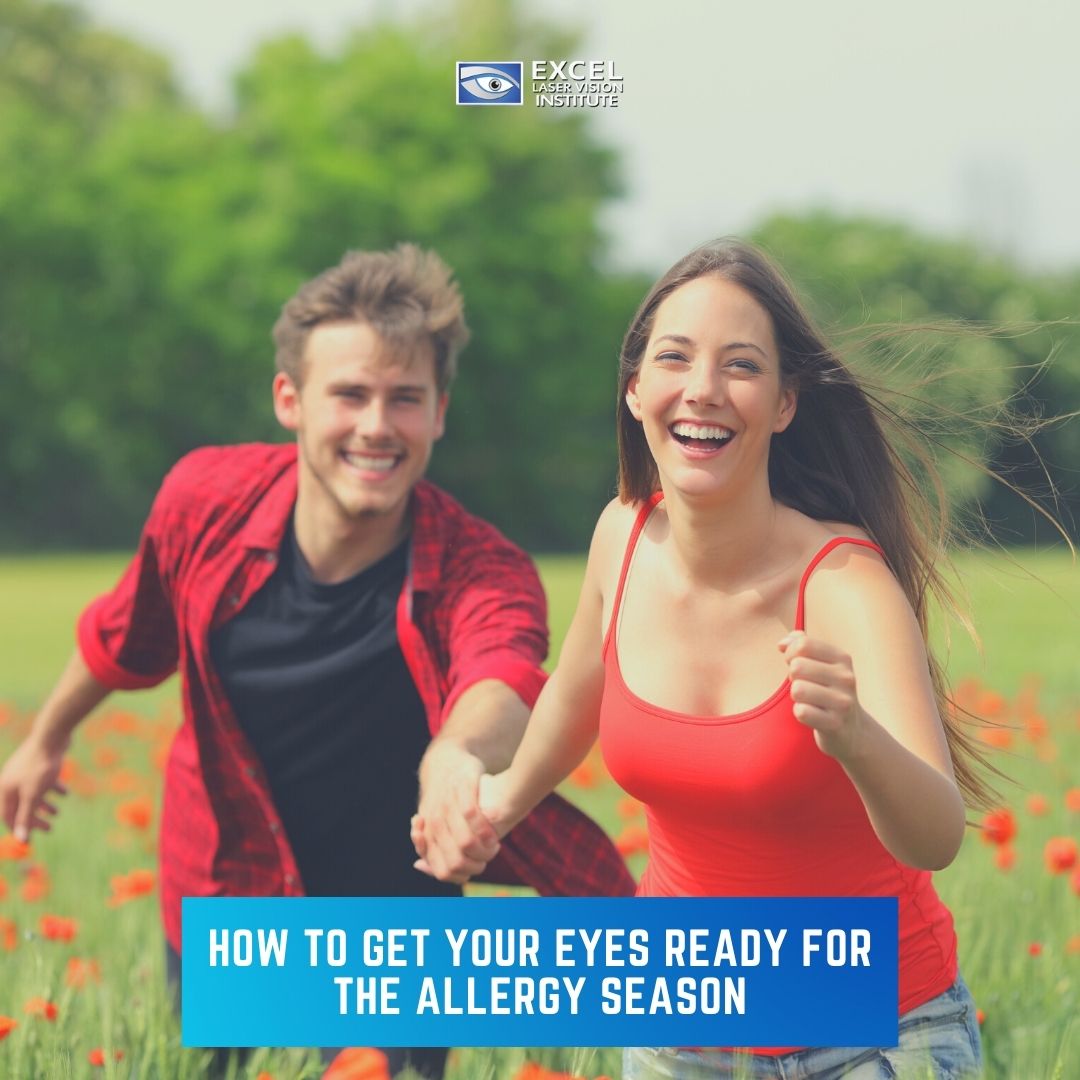
How To Get Your Eyes Ready for the Allergy Season
Many eye doctors will tell you that eye allergies will affect many people at some point in their lives. Still, unfortunately, some people will suffer more than others when it comes to eye allergies, particularly during the Spring through Fall months. Most ophthalmologists specialize in treating many eye conditions and serve the requirements of individuals looking for eye care.
The warmer weather and longer days bring some dangers to your eyes and vision. The springtime bloom causes red, swollen, and itchy eyes. Also, there’s an increase in sun damage because of sun exposure, so it is important to protect your eyes this spring season.
What Are Common Eye Allergy Symptoms?
While the pollen, dust, and dander start a ruckus outside, so do your allergies. Although some people just suffer from sneezing or maybe even sometimes a stuffy nose, others experience allergies that affect their eyes, which makes springtime a horrible moment for them.
If your eyes become so red and itchy that you notice a puss-like discharge from your eyes, you should get an eye exam immediately. In fact, it is not uncommon for people to mistake an infection for allergies.
However, with the right precautions, you can reduce the discomfort of increased allergens and sun exposure. Here are some handy tips to follow this Spring for healthy eyes.
Common Eye Allergy Symptoms
Redness
Burning
Itching
Clear or watery discharge
Blurred vision
What Causes Seasonal Allergies?
So many things, from dust to perfume to pet dander, can cause allergies, and they aren’t always restricted to a specific year. Nevertheless, Spring and fall are usually worse because of the pollen. Some plants such as grass pollinate in the Spring, while others such as ragweed pollinate in the fall.
During these months, the air becomes full of tiny floating particles that can get into our eyes and airways which causes irritation. If you are a person with an overactive immune system , you will probably experience symptoms such as itchy eyes, congestion, and persistent sneezing.
The most common triggers of eye allergies include:
Outdoor Allergens – Pollens, mold, and dust from trees, weeds, flowers, and grass.
Indoor Allergens – Pet dander, mold, dust mites, and indoor plants.
Irritants include perfumes, cigarette smoke, cosmetics, eye drops, or exhaust fumes.
To be clear, food allergies and insect bite allergies do not affect the eyes like airborne allergens.
How Do Eyes Respond To Allergens?
Normally, allergy symptoms include redness, itchiness, and watering of the eyes. Sometimes it comes with a gritty feeling, swollen eyelids, a burning feeling, and increased discomfort with contact lenses. You can ease these symptoms with decongestants since they help with respiratory symptoms. However, a side effect is sometimes that they dry the eyes out, making the eye symptoms worse and leaving the eyes more susceptible to airborne irritants.
How To Protect Your Eyes This Spring?
A good way to protect your eyes this Spring is to reduce your exposure to the dander, dust, and pollen that causes red, swollen, and itchy eyes. Allergens can appear any time of the year but really intensify in the Spring. These tiny floating particles get inside your home and rapidly irritate your eyes.
Here are some methods to lower allergens inside your home:
Take a look at your HVAC system and make sure the air filters are working and clean.
Routinely clean your home by mopping, sweeping, and dusting.
Do your best to keep your windows closed as much as possible.
Don’t place fans near windows that could blow pollen inside.
Wearing Clean Clothes Helps
Clothes attract airborne pollen and dust particles, and they attach themselves to your clothing, shoes, shoelaces, hats, or anything that you are wearing. A good method of minimizing these allergens in your home is to wash your clothes regularly. Also, do not overlook cleaning your shoes too.
Eye Drops Help To Clear Your Vision
Typically, dry eyes are one of the symptoms of pollen and dander allergies. Making sure your eyes are moist and flushed is the most effective way to avoid red, itchy, and dry eyes.
You should use good quality preservative-free artificial tears or eye drops that help to lubricate the eyes to relieve you of allergy symptoms. Also, artificial tears are an excellent all-year-round product to have on hand if you are a contact lens wearer to prevent them from drying out. Occasionally medicated or prescription eye drops may be required to alleviate ocular allergies.
It’s best to visit your optometrist to first get diagnosed and begin the proper allergy medication to have your feeling brand new again.
Wear Sunglasses
Sunglasses are more than just a fashion statement since the sun comes along with the warmer spring weather. The increased time outdoors exposes you to more allergens and more of the sun’s harmful UV rays.
Sunglasses protect the eyes by adding a barrier between the pollen floating around in the air and your eyes. The bigger the sunglasses you wear, the more protection you will have! Also, UVA/UVB sunglasses filter out harmful rays and make sure your eyes stay healthy.
When dirty hands touch your eyes, it can cause infections as well as overall irritability. Plus, sunglasses lower how often you touch your eyes.
If you wear prescription glasses, discuss with your optometrist about prescription sunglasses so you can see clearly as you protect your eyes.
Wear Glasses Rather Than Contacts
Pollen and other allergens easily accumulate and get stuck on your contact lenses during the Spring. This can worsen your symptoms and extend your suffering. If you can, wear your glasses as much as you can to give your eyes a rest. You will lower the accumulation of pollen particularly when outdoors.
If you can’t remove your contacts or wear glasses, try cleaning them more than usual in an eye contact solution. This will get rid of any gathered allergens and lubricate them simultaneously.
Go For Routine Eye Check-Ups
Last but not least, to make sure eye allergies don’t spoil your spring season, you should schedule regular eye examinations with your eye doctor. If you are sensitive to allergy symptoms, an optometrist can use preventive measures to prepare you for whatever Spring has up its sleeve.
Treatments For Common Eye Allergies
Swollen Eye
Swollen eyes or eye swelling occurs when the person suffers from a lack of sleep or has an allergic reaction. A swollen eye happens because of fluid retention in the eye, and it can be concerning and also very painful. You can sometimes treat a swollen eye at home. Nevertheless, if the eye condition becomes agonizing, chronic, or chronic, it is highly recommended that you visit your eye doctor immediately.
Allergic Conjunctivitis
This is a condition that happens when the eye becomes sensitive or inflamed, and can even be painful. The treatment of this condition needs both prevention and treatment. Individuals who suffer from very intense allergies that regularly cause this problem must avoid open-air during allergy season and have their allergy drops on hand and possibly other medications such as antihistamines. steroid eye drops may be needed for those with recurring conjunctivitis.
Swollen Upper Eyelid
Another common indication of conjunctivitis is that a swollen eyelid can be uncomfortable, but many prefer a swollen eye. Like eye swelling, those who develop this condition frequently need to take preventative measures to avoid allergens and be prepared with allergy eye drops and other medications.
Itchy Watery Eyes
Itchy eyes and watery eyes are typical symptoms of mild to moderate eye allergies. Watery eyes can be tricky if the wateriness is severe, especially if you have to operate machinery. Itchy eyes will usually be followed by watery eyes and can be really annoying. Simple medications such as allergy eye drops can help. It is mainly essential to avoid rubbing your eyes with your hands or with anything that may not be sanitary.
Your eye doctor at Excel Laser Vision Institute recommends using suitable products and medications to help relieve symptoms and prevent them from becoming more severe. Prolonged eye irritation can result in eye issues and infections if left untreated.
So, don’t put your eye health at risk. Book an appointment and get a head start on a clean, comfortable, and allergy-free spring season.
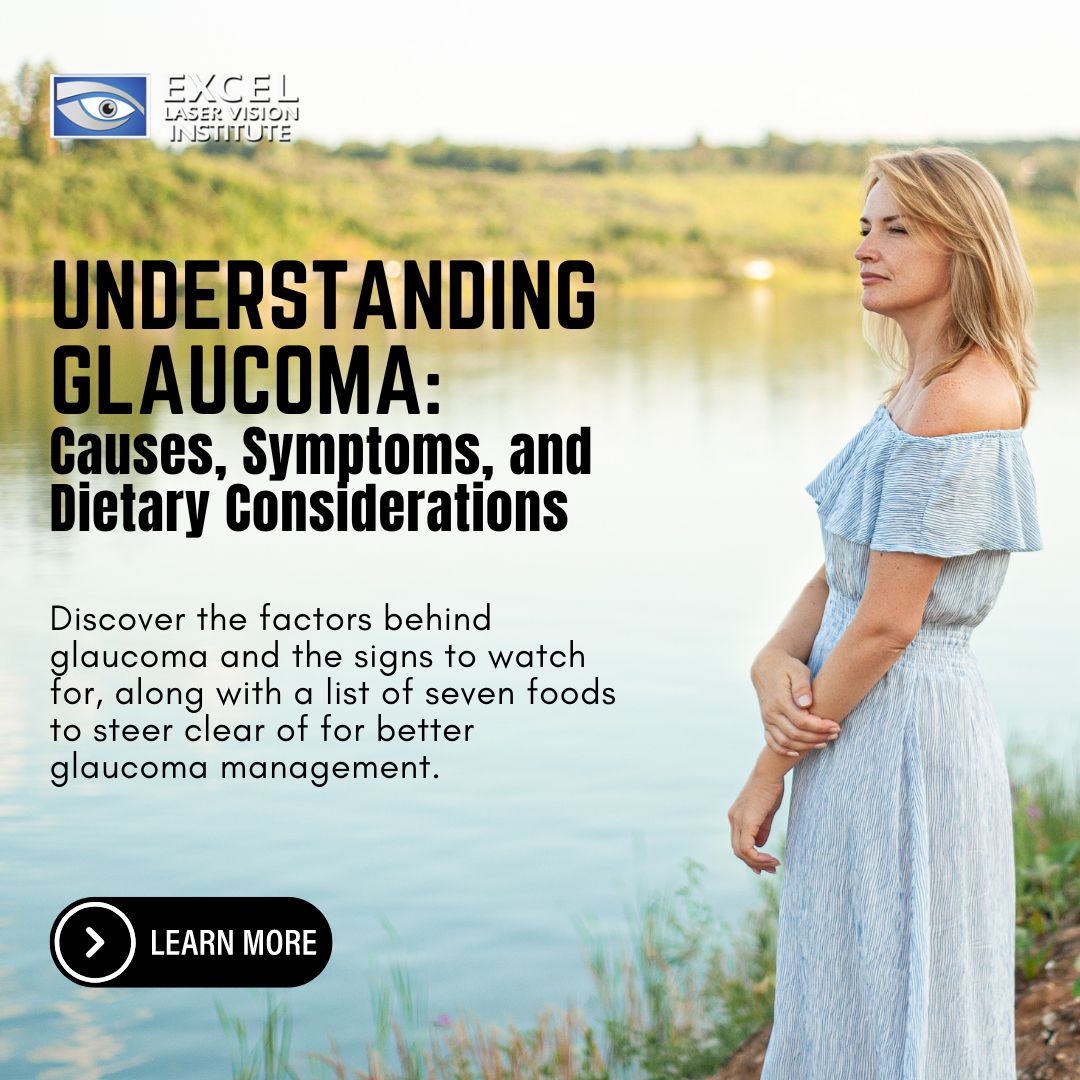
Understanding Glaucoma: Causes, Symptoms, and Dietary Considerations
On average, the eye doctors tell us that about three million Americans have glaucoma, however, only half of them know it.
Unfortunately, glaucoma is an eye disease that eye doctors at the best laser eye surgery orange county don’t take lightly because it’s the second leading cause of vision loss and blindness in the world. The two most common forms of glaucoma that patients have are Primary Open-Angle Glaucoma and Acute Angle-Closure Glaucoma.
What Causes Glaucoma?
Glaucoma occurs when there is damage to the optic nerve. While this nerve slowly deteriorates, blind spots appear in a person’s visual field. The medical community still doesn’t understand why the optic nerve becomes damaged, but it could be related to increased pressure in the eye.
Elevated eye pressure usually comes about because of the accumulation of fluid, known as aqueous humor, that moves throughout the inside of the eye. This internal fluid usually drains out by way of a tissue called the trabecular meshwork at the angle where the iris and cornea come together. When too much fluid is produced or the drainage system doesn’t work correctly, the fluid can’t move at its normal pace, and eye pressure increases.
Typically, glaucoma runs in families. Also, scientists have been able to find genes in some people that are related to high eye pressure and optic nerve damage.
What Are The Symptoms of Primary Open-Angle Glaucoma?
The eye doctors usually call open-angle glaucoma “the silent thief of sight” since it has no symptoms until permanent vision loss has happened. Symptoms in advanced stages of the disease consist of the following::
-
Progressive loss of peripheral vision, usually in both eyes
-
Blank spots in the person’s field of vision
-
Tunnel vision in the advanced stages
Regular eye exams are critical to detect this type of glaucoma early enough to successfully treat the condition and prevent further loss.
What Are The Symptoms Of Acute Angle-Closure Glaucoma?
An angle-closure glaucoma is an uncommon form of glaucoma, which develops very rapidly and requires immediate medical attention.
It’s the complete opposite of open-angle glaucoma since the symptoms of acute angle-closure glaucoma are very noticeable and damage happens quickly. If you experience any of these symptoms, seek immediate care:
-
Eye pain
-
Sudden onset of visual disturbance, often in low light
-
Nausea and vomiting (accompanying the severe eye pain)
-
Blurred vision
-
Halos around lights
-
Headache
-
Nausea
-
Reddening of the eye
Who Is At High Risk At Developing Glaucoma?
On account of the fact that chronic forms of glaucoma can harm a person’s vision before any signs or symptoms are noticeable, take a look at this list of higher risk factors:
-
Age – If you are over 40
-
Elevated intraocular (internal) eye pressure
-
Family history of glaucoma
-
Ethnic background – African Americans, Asians, and Japanese have a higher risk
-
Long-term corticosteroid use
-
Medical conditions – Such as diabetes or high blood pressure
7 Foods to Avoid When You Have Glaucoma
While various factors contribute to the development and progression of glaucoma, including genetics and increased intraocular pressure, certain dietary choices may impact the condition. While there is no specific glaucoma diet, some foods and lifestyle habits are generally advised for those with glaucoma. Here are foods that individuals with glaucoma may consider avoiding or limiting:
High-Sodium Foods
Excessive salt intake can eventually lead to increased blood pressure, which, in turn, may contribute to elevated intraocular pressure (IOP). Individuals with glaucoma are often advised to limit their sodium intake to help sufficiently manage their condition. Processed foods, canned soups, and salty snacks should be consumed in moderation.
Caffeine
Some studies suggest that caffeine may temporarily increase intraocular pressure. While the evidence is inconclusive, individuals with glaucoma may choose to monitor their caffeine intake. This includes coffee, tea, energy drinks, and certain caffeine medications.
High-Sugar Foods
Diets high in sugar have long been associated with various health issues, including diabetes. Individuals with diabetes have a considerably increased risk of developing certain types of glaucoma. Therefore, managing sugar intake is essential for overall health and potentially for glaucoma management.
Fried and Fatty Foods
High-fat diets may contribute to obesity and other health problems, indirectly affecting eye health. Fried and fatty foods, particularly those high in trans fats and saturated fats, must be limited. Instead, individuals are encouraged to include healthy fats like omega-3 fatty acids typically found in fish, flaxseeds, and walnuts.
Processed Foods
Processed foods often are packed with unhealthy additives, preservatives, and trans fats. These can contribute to inflammation and other various health issues that may indirectly impact eye health. Opting for fresh, whole foods is generally a better choice.
Alcohol
Excessive alcohol consumption can be causation for dehydration and may impact the body’s ability to regulate intraocular pressure. Individuals with glaucoma should moderate their alcohol intake and stay well-hydrated.
High-Glycemic Index Foods
Foods with a high glycemic index can cause rapid spikes and crash in blood sugar levels. Maintaining stable blood sugar levels is crucial for overall health, including eye health. Choosing low-glycemic index foods like whole grains, fruits, and vegetables may be beneficial.
Conclusion
Glaucoma, a group of eye conditions causing optic nerve damage, necessitates attention to dietary choices. While not a substitute for medical care, avoiding or limiting certain foods may aid in managing the condition. High-sodium foods linked to increased blood pressure and caffeine, which might temporarily elevate intraocular pressure, should be moderated. Diets high in sugar pose risks, particularly for those with diabetes, increasing the importance of managing sugar intake. Limiting fried and fatty foods and processed items with unhealthy additives and moderating alcohol consumption contribute to a comprehensive approach.
Additionally, it’s important to note that while dietary choices may play a role in managing overall health and potentially influencing glaucoma, they are not a substitute for medical treatment. Regular eye check-ups, prescribed medications, and lifestyle modifications should be discussed with an ophthalmologist or healthcare professional to craft a comprehensive plan tailored to individual needs. Everyone’s health needs are unique so that specific dietary recommendations may differ from person to person. Always consult a healthcare provider for specialized advice based on individual health conditions and concerns.


